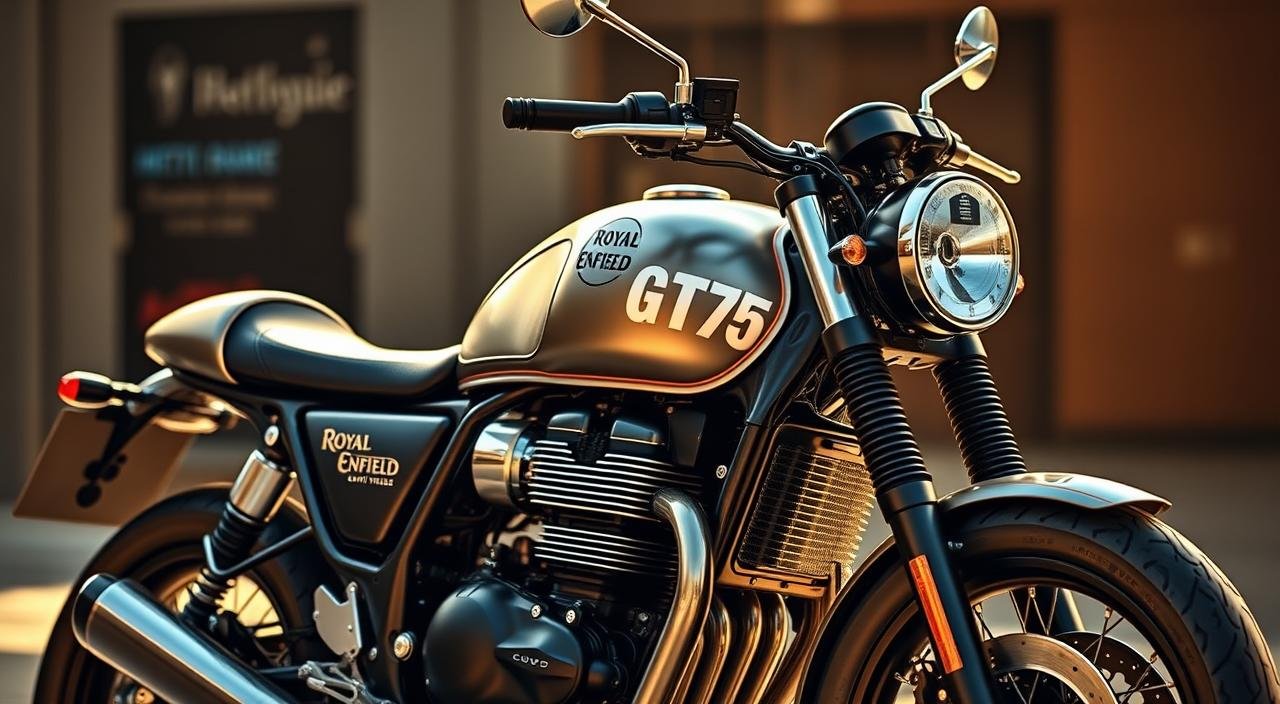
Nov
Can Royal Enfield challenge the mid-size sportbike segment with a new machine? The Royal Enfield Continental GT-R 750 debuts at EICMA 2025 with a surprising answer. This marks a big moment for the Indian manufacturer as it explores new territory.
The Continental GT-R 750 hit the Milan show floor with big promises. It’s built on an expanded 650cc platform with a new 750cc parallel-twin engine that makes 55-60 horsepower. Royal Enfield showed the bike with wooden pallets, Ladakh prayer flags, and Himalayan images, mixing performance with heritage.
EICMA 2025 highlights included Royal Enfield’s move into the 750cc category. The Continental GT-R 750 and the Himalayan 750 show the brand’s growth. The company will share full specs and production details at EICMA 2026.
Key Takeaways
- Royal Enfield Continental GT-R 750 debuts at EICMA 2025 with an expanded 750cc engine
- Power output estimated at 55-60 horsepower from the parallel-twin configuration
- Display featured cultural elements including Ladakh prayer flags and Himalayan imagery
- The GT-R 750 joins the Himalayan 750 in Royal Enfield’s new displacement category
- Full technical specifications and production details scheduled for EICMA 2026 reveal
- Expected price range sits between ₹3.50 to ₹4.10 lakh for the Indian market
Overview of the Royal Enfield Continental GT-R 750
The new Royal Enfield Continental GT-R 750 is a big step up for the brand. It comes from the successful 650cc platform that has been loved by riders for years. This cafe racer mixes classic looks with the latest tech, pleasing both old-school fans and speed lovers.
Key Specifications
The Continental GT-R 750 has some exciting upgrades. Its heart is a new 750cc parallel-twin engine. This engine is a big leap from Royal Enfield’s earlier models.
| Specification | Continental GT-R 750 | Continental GT 650 |
|---|---|---|
| Engine Displacement | 750cc | 648cc |
| Power Output | 55-60 HP | 47 HP |
| Torque | 65 Nm (estimated) | 52.3 Nm |
| Cooling System | Air/Oil-cooled | Air/Oil-cooled |
| Front Brakes | Twin-disc | Single disc |
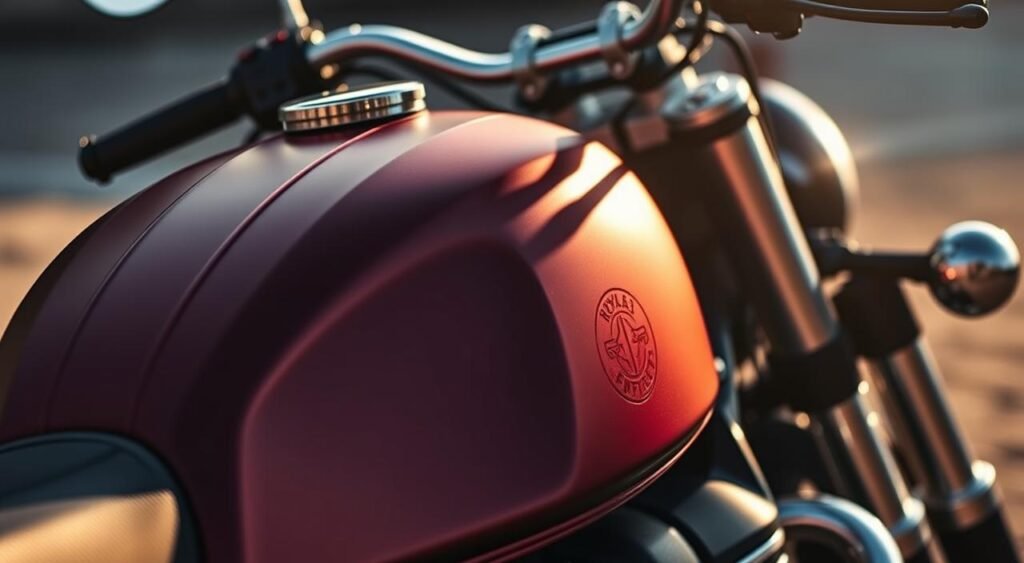
Design Features
The new Royal Enfield keeps its classic look but adds useful updates. Wire-spoke wheels now come with tubeless tires. This mix of old and new is both stylish and practical. The bike also shows off Royal Enfield’s rich history with its branding on the crankcase.
Performance Metrics
The Continental GT-R 750 is built for long rides. Its bigger engine gives better power in the middle range. This makes long trips easier and keeps the bike fun to ride.
EICMA 2025 Highlights and Significance
EICMA is a top motorcycle event in 2025, attracting people from all over to Milan. This year, it was filled with exciting reveals that hinted at what’s coming next. The latest designs and tech on display will guide the industry’s future.

What to Expect from EICMA
The Milan show is where big names unveil their latest models. Visitors will see groundbreaking innovations in electric bikes, safety, and performance. With over 700 exhibitors, it’s a showcase of everything from high-speed bikes to city-friendly rides.
There are interactive displays and test rides, making it more than just a look. It’s an experience.
Royal Enfield’s Role at EICMA
Royal Enfield was a highlight with a unique presentation. They showed off the Continental GT 750 and Himalayan 750 test mules, covered on wooden pallets. This built excitement for their full reveals in 2026.
Their booth had a mountain theme, showing off their adventure touring focus. This marks Royal Enfield’s big move into the middleweight segment. They’re going up against big names like Kawasaki Versys 650 and Triumph Tiger Sport 660.
Their presentation style at motorcycle events 2025 shows their confidence. They’re creating buzz while keeping their future launches a secret.
Innovative Technology in the Continental GT-R 750
The Royal Enfield Continental GT-R 750 is unveiled at EICMA 2025. It comes with the latest tech, blending modern features with classic Royal Enfield style. This bike is designed for long rides, combining new engineering with timeless looks.
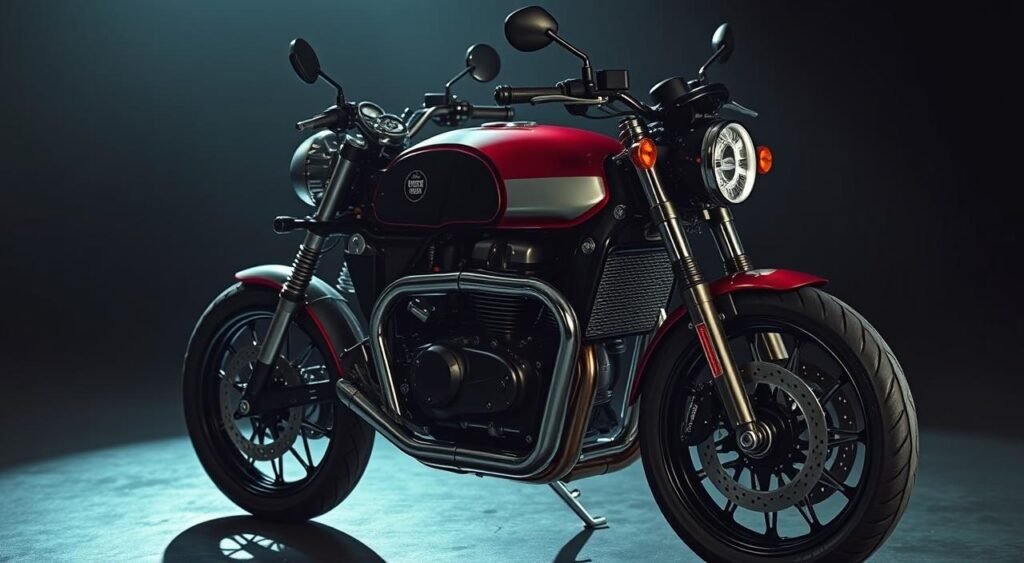
Engine Advancements
The 750cc parallel-twin engine is a big step up from the 650cc model. It has more power and a better powerband for highway riding. The engine gives smooth power from 3,000 to 7,000 rpm, making it easy to pass cars on Indian roads.
Key improvements include:
- Enhanced cooling system for better heat management
- Refined fuel injection mapping for improved throttle response
- Optimized gear ratios for touring comfort
- Reduced vibrations through better engine balancing
Riding Modes and Features
The Continental GT-R 750 has exciting tech features. It has a TFT display like the Himalayan 450 and the Tripper navigation system. You can connect your smartphone for directions on the dashboard.
The bike also has adjustable suspension with inverted front forks. You can adjust them for different road conditions. All-LED lighting makes night rides safer. These features make the Continental GT-R 750 a top choice for long trips in India.
Target Audience and Market Expectations
The Continental GT-R 750 is a key player in the middleweight motorcycle market. It’s designed for riders who want great performance without breaking the bank. This bike bridges the gap between the 650cc and liter-class bikes, making it affordable for many.
Who is the Continental GT-R 750 For?
This bike is perfect for experienced riders looking for an upgrade. It’s great for those who love adventure tours and daily commutes. It’s aimed at professionals aged 25-45 who value both weekend fun and daily practicality.
Urban riders will love the 750cc engine for its refined performance. It combines classic looks with modern reliability. Long-distance riders will enjoy the improved ergonomics for long rides across India’s varied landscapes.
Expected Reception in India
Analysts expect high demand for this Royal Enfield in India. Priced at Rs 4.5 lakh ex-showroom, it’s set to compete with Kawasaki Ninja 650 and Honda CB650R. This price keeps Royal Enfield’s value while boosting performance.
Indian riders are keen on middleweight bikes. The Continental GT-R 750 comes at a great time, after EICMA 2025 highlights. Dealers are already seeing lots of interest, with many pre-bookings expected once it’s officially announced.
Comparisons to Other Royal Enfield Models
The Continental GT-R 750 is a big step up for Royal Enfield. It brings new features to the table while keeping the classic feel. This makes it easier for riders to choose the right bike for them.
GT-R 750 vs. Interceptor 650
The Continental GT-R 750 has a bigger engine than the Interceptor 650. It has 55 to 60 horsepower, while the Interceptor has 47. Both bikes have the same quality and look, with shiny tanks and chrome parts.

The way you sit on the bike is different between the two. The GT-R 750 is more for the road, while the Interceptor is better for long trips. Instrument clusters remain familiar, with both bikes having old-school speedometers and digital screens for other info.
GT-R 750 vs. Continental GT 650
The GT-R 750 has more power than the Continental GT 650. It has 8-13 more horsepower because of its bigger engine. Both bikes have the cool café racer look that Royal Enfield fans love.
| Model | Engine Size | Power Output | Torque |
|---|---|---|---|
| Continental GT-R 750 | 750cc | 55-60 HP | 65 Nm (estimated) |
| Continental GT 650 | 648cc | 47 HP | 52.3 Nm |
| Interceptor 650 | 648cc | 47 HP | 52.3 Nm |
Riders who want the best of both worlds will like the GT-R 750. It’s great for those who want good fuel efficiency and lots of power. Royal Enfield has kept its classic charm while making the bikes better for today’s riders.
Environmental Considerations and Sustainability
The Royal Enfield Continental GT-R 750 shows the brand’s dedication to both performance and the environment. This new model is a big step towards making motorcycles more eco-friendly. It keeps the classic look that fans love.
Emissions Standards
The Continental GT-R 750 meets tough global emission rules thanks to new tech. Its air/oil-cooling system works better than before. This helps cut down on bad emissions, keeping the ride exciting for fans at motorcycle events 2025.

Eco-Friendly Features
Royal Enfield added green tech to the GT-R 750. The bike now has wire-spoke wheels with tubeless tires. This means less upkeep and less trash for the planet.
The bike’s engine is tuned for better fuel use and performance. These changes make the GT-R 750 a great choice for eco-conscious riders. It’s a big deal in motorcycle news about green riding.
| Feature | Environmental Benefit | Rider Advantage |
|---|---|---|
| LED Lighting | 60% less energy consumption | Longer battery life |
| Tubeless Tires | Reduced waste disposal | Lower maintenance costs |
| Optimized Cooling | Better thermal efficiency | Consistent performance |
| Fuel Mapping | Reduced CO2 emissions | Improved mileage |
Pricing and Availability in India
The Royal Enfield Continental GT-R 750 is set to debut at EICMA 2025. It will have prices that appeal to motorcycle fans in India. The goal is to grab a big share of the premium market without breaking the bank.
Once the prototype is shown, the real models will hit the market. They will have all the details and specs that fans want to see. This will happen at next year’s big motorcycle shows.
Expected Price Range
Royal Enfield is aiming to price the Continental GT-R 750 at around Rs 4.5 lakh. This is before taxes and is for the Indian market. It’s cheaper than bikes like the Kawasaki Versys 650 and Triumph Tiger Sport 660.
This price shows Royal Enfield’s dedication to quality and affordability. They want to offer powerful bikes that are easy on the wallet for Indian riders.
Pre-Booking Details and Launch Date
The Continental GT-R 750 is expected to arrive in India by late 2026. The models will be ready after EICMA 2026. Royal Enfield’s Motoverse event in November might share details on booking and where to find the bikes.
Soon before the launch, Royal Enfield will announce when you can pre-book. This gives customers time to compare it with other bikes in the market.
FAQ
What engine powers the Royal Enfield Continental GT-R 750?
The Continental GT-R 750 has a new 750cc parallel-twin engine. It’s an upgrade from Royal Enfield’s 650cc platform. This engine is expected to make about 55-60 horsepower, perfect for long rides.
When will the Continental GT-R 750 be available for purchase?
We’ll see the Continental GT-R 750 at EICMA 2026. It’s set to hit the market in late 2026. Royal Enfield showed test mules at EICMA 2025 to build excitement. More news might come at Motoverse on November 21-23.
What is the expected price of the Continental GT-R 750 in India?
In India, the Continental GT-R 750 is expected to cost around Rs 4.5 lakh ex-showroom. This price is lower than competitors like the Kawasaki Versys 650 and Triumph Tiger Sport 660. It keeps Royal Enfield’s value in the middleweight segment.
How does the Continental GT-R 750 compare to the current 650cc models?
The GT-R 750 has 55-60 horsepower, more than the current 650cc models’ 47 horsepower. It has the same platform but with big upgrades. These include adjustable suspension, all-LED lights, and a possible TFT display.
What were the EICMA 2025 highlights for Royal Enfield?
At EICMA 2025, Royal Enfield showed the Continental GT 750 and Himalayan 750 test mules. They were on wooden pallets with Ladakh prayer flags and Himalayan images. This marked Royal Enfield’s entry into the middleweight segment, sparking excitement for EICMA 2026.
What advanced features will the Continental GT-R 750 include?
The Continental GT-R 750 will have a Tripper navigation display for smartphone connectivity. It will also have inverted forks, twin-disc front brakes, and wire-spoke wheels. These features are designed for better performance and to meet international emission standards.
Who is the target audience for the Continental GT-R 750?
The Continental GT-R 750 is for middleweight adventure-tourer fans. It offers more power than the 650cc range but at a lower price. It’s great for long trips with its larger fuel tank.

Nov
Can a motorcycle brand that started before cars became mainstream surprise us in 2025? Royal Enfield shows it’s possible by celebrating 125 years with amazing bikes. These bikes mix old-school charm with modern tech.
The iconic brand celebrated Royal Enfield Turns 125 at EICMA 2025 with six amazing bikes. The Classic 650 Special Edition Revealed was joined by the new Bullet 650 and special Anniversary Edition models. Each bike shares a century-long tale of skill and tradition.
The Anniversary Edition has cool gold insignia on deep red paint and Hypershift coating that changes colors. Royal Enfield also showed off the Himalayan Mana Black, a Shotgun 650 collaboration with Rough Crafts, and the Flying Flea Scrambler. They teased the upcoming Himalayan 750, making fans even more excited.
Key Takeaways
- Royal Enfield celebrates 125 years with six new motorcycle models at EICMA 2025
- Classic 650 Anniversary Edition features exclusive gold insignia and color-shifting Hypershift paint
- New Bullet 650 comes with 647cc parallel-twin engine producing 46hp and 52Nm torque
- Limited Shotgun 650 collaboration with Rough Crafts restricted to 100 units worldwide
- Himalayan 450 Mana Black Edition delivers 40hp from its 452cc liquid-cooled engine
- Flying Flea Scrambler and Himalayan 750 preview future product directions
The Legacy of Royal Enfield: A Celebration of 125 Years
Royal Enfield is one of the oldest motorcycle makers in the world. It has been making bikes for 125 years. This journey started in 1901 and has made it a favorite in India.
Historical Milestones in Royal Enfield’s Journey
The brand’s story began in Redditch, England. It made its first motorcycle there. Important moments include:
- 1932: Introduction of the iconic Bullet model
- 1955: Partnership with Madras Motors in India
- 1962: Establishment of manufacturing in Chennai
- 1990s: Revival under Eicher Motors ownership
- 2013: Launch of Continental GT café racer

Key Innovations Over the Years
Royal Enfield has changed a lot over time. The Bullet series is a big part of its history. It now has hand-painted pinstripes and classic emblems.
Recently, it teamed up with Rough Crafts for the Shotgun 650. This made special bikes for collectors. Each bike is a mix of custom and factory quality.
Impact on the Motorcycle Community
Royal Enfield has a big following in India and worldwide. It hosts rides and rallies for fans. Riding clubs exist all over, celebrating the love for bikes.
This celebration honors the millions of riders who love Royal Enfield. They have made the brand more than just a bike.
Introduction to the Classic 650 Special Edition
Royal Enfield is celebrating 125 years with the Limited Edition Classic 650. This motorcycle honors the brand’s rich history. It combines classic design with modern tech, making it a rare find in India’s high-end bike market. The Classic 650 Special Features include unique looks and special touches that make it stand out.
Design Elements of the Special Edition
The Limited Edition Classic 650 has a deep red paint job with a gold 125 Years insignia. Its fuel tank has a special ‘Hypershift’ paint that shimmers in light. It also has round LED headlights and classic fenders, keeping the Royal Enfield look alive. You can choose from Vallam Red, Bruntingthorpe Blue, Teal, and Black Chrome.
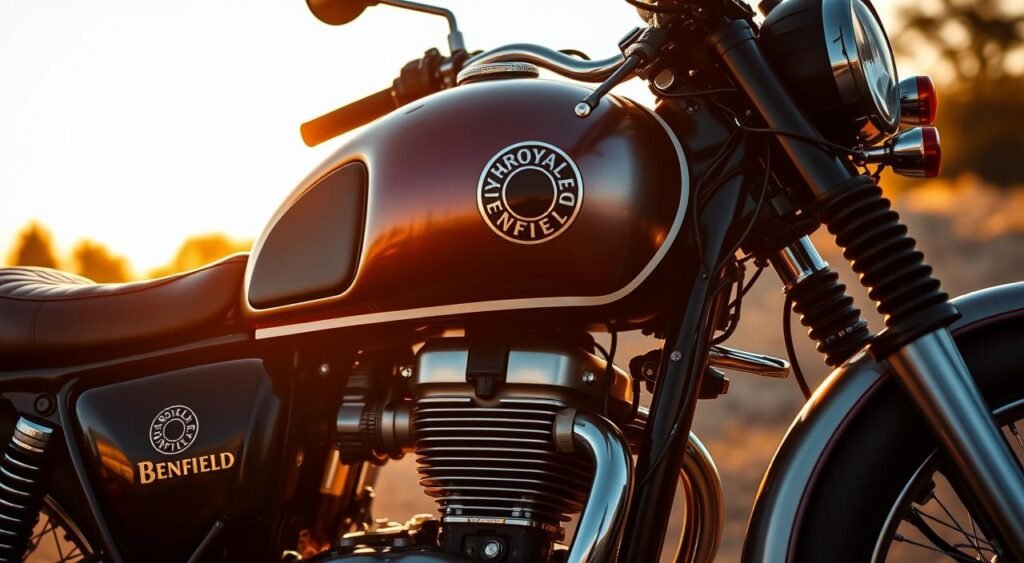
Performance Features of the Classic 650
The Classic 650 has a strong 647cc engine that makes 46 horsepower and 52 Nm of torque. It’s built on a steel frame for stability. It has big brakes and ABS for safety. It also gets great fuel efficiency, at.45.
Customization Options Available
Royal Enfield lets you customize the Limited Edition Classic 650. You can adjust the levers for better fit and comfort. It comes with a USB port and a navigation system. The seat height is 800mm, and the fuel tank is 14.7 liters, perfect for long rides.
| Specification | Limited Edition Classic 650 |
|---|---|
| Engine Capacity | 647.95 cc |
| Power Output | 47.04 PS |
| Torque | 52.3 Nm |
| Kerb Weight | 243 kg |
| Fuel Tank | 14.7 litres |
| Price | ₹3,90,000 |
Exclusive Features of the Classic 650 Special Edition
Royal Enfield’s Anniversary Edition turns the Classic 650 into a collector’s dream. It celebrates 125 years of motorcycle heritage with top-notch craftsmanship. Each detail shows the company’s dedication to blending traditional looks with modern engineering.
Unique Color Schemes and Finishes
The Anniversary Edition shines with its eye-catching visuals. Real gold leaf stripes adorn the fuel tank, adding elegance. These stripes are shadowed in grey for depth and style.
Hand-cast solid brass tank badges replace standard emblems, bringing vintage charm. The quilted leather seats have custom patterns, making the bike stand out. This model offers both comfort and a unique look.

Upgraded Technology and Accessories
Technical upgrades enhance the ride. The six-speed gearbox has an assist-and-slipper clutch system for smoother gear changes. Bar-end mirrors boost visibility without changing the bike’s classic look.
Contrast-cut alloy wheels and gold inner fork tubes make a striking combo. This visual mix grabs attention wherever you go.
Enhanced Rider Experience
Each Anniversary Edition comes with exclusive art prints from Rough Crafts. These mark their Shotgun 650 collaboration. The bikes are numbered, ensuring each one is unique and authentic.
These thoughtful touches make owning one special. Every ride becomes a celebration of Royal Enfield’s journey.
Market Response and Anticipation
The excitement for Royal Enfield’s 125th birthday is huge. Motorcycle fans all over India can’t wait for the special edition bikes. The brand’s plan to make only a few bikes has really caught people’s attention.
Reactions from Enthuasiasts and Collectors
The news of just 100 Shotgun 650 x Rough Crafts bikes has collectors worldwide buzzing. These bikes will be sold in India, Europe, North America, and APAC. This means each area will get a small number, making them rare and valuable.
Royal Enfield chose to give these bikes to true fans instead of selling them to everyone. This shows they really care about their customers.
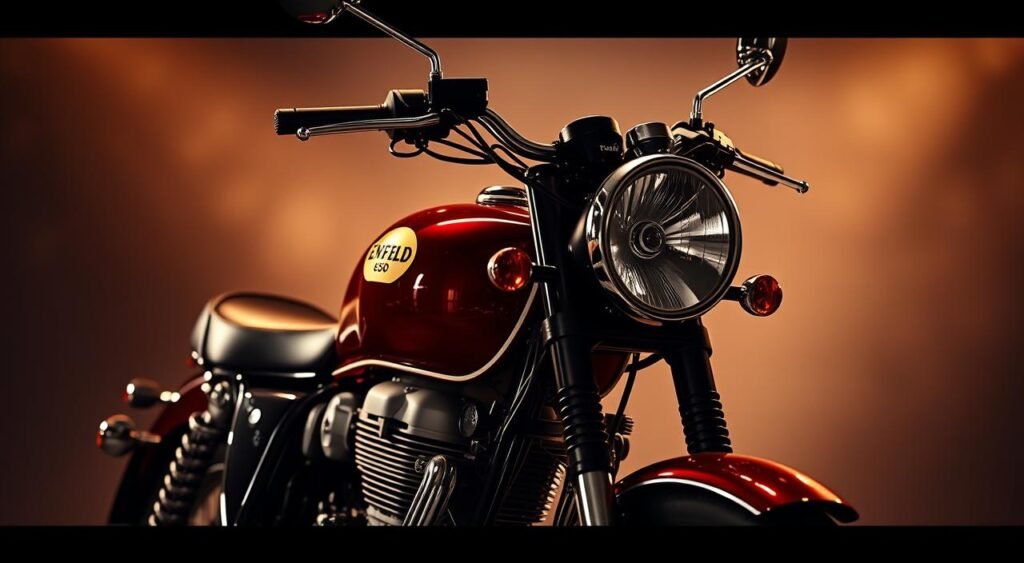
Expected Demand in India
Indian riders are really excited about the Himalayan Mana Black edition. It comes with adventure gear like black handguards and a rally seat. This bike is perfect for India’s growing adventure bike fans.
With Indian motorcycle sales expected to reach 28 million, Royal Enfield’s timing is spot on.
Pricing Strategy and Comparisons
Royal Enfield will share prices for bikes like the Flying Flea FF.S6 electric scrambler soon. They want to see how the market is doing before they set prices. As they celebrate 125 years, they aim to keep prices high for exclusivity but also affordable for their loyal fans.
Looking Ahead: The Future of Royal Enfield
Royal Enfield is at a thrilling point as it marks a major year. The brand, known for the Classic 650 Special Edition, aims to introduce new models. It’s exploring electric bikes and bigger engines, aiming to enter premium markets while keeping its roots.
Upcoming Models to Watch
The Flying Flea FF.S6 is Royal Enfield’s first electric bike. It has a strong motor and magnesium battery, with USD forks and dual brakes. It rides on big wheels for better performance.
The Himalayan 450 Mana Black is ready for tough off-road adventures. It has a 452cc engine and is built for serious riding. Royal Enfield is also working on the Himalayan 750, aiming for bigger engines for the world.
Focus on Sustainability and Innovation
The Flying Flea highlights Royal Enfield’s focus on electric tech. It has a cool round touchscreen and advanced connectivity. It also has voice control and ABS, showing the brand’s dedication to modern, green riding.
The Brand’s Role in the Global Motorcycle Scene
Royal Enfield is growing its global reach with new models. It’s targeting high-end markets with bikes that mix old-school looks with new tech. In India, prices are competitive, while worldwide, bikes are made to fit local tastes. The success of the Classic 650 shows Royal Enfield can appeal to new fans globally.
FAQ
What makes the Classic 650 125th Anniversary Special Edition unique?
The Anniversary Edition has stunning cosmetic updates. It features a 125 Years insignia in gold over deep red paint. The tear-drop fuel tank has ‘Hypershift’ paint that creates kaleidoscopic effects.
It also has real gold leaf stripes and hand-cast solid brass tank badges. The quilted leather seats have custom patterns. Each bike has a 647cc parallel-twin engine, producing 46hp and 52Nm torque.
How many units of the Shotgun 650 x Rough Crafts Limited Edition will be produced?
Royal Enfield will make only 100 units of the Shotgun 650 x Rough Crafts. These bikes will go to India, Europe, North America, and Asia-Pacific. Each bike comes with exclusive art prints signed by Rough Crafts.
What new motorcycles did Royal Enfield showcase at EICMA 2025?
At EICMA 2025, Royal Enfield showed off the new Bullet 650. It has hand-painted pinstripes and classic emblems. They also introduced the Classic 650 Special Edition and Himalayan Mana Black edition.
Other models included the limited-run Shotgun 650 and the all-new Flying Flea Scrambler. They also teased the Himalayan 750, but details are not yet available.
When will the Flying Flea electric scrambler be available?
The Flying Flea FF.S6 electric scrambler will launch in late 2026. It has a high-torque electric motor and a magnesium battery case. It also has a round TFT touchscreen display and 4G/Bluetooth/Wi-Fi connectivity.
It comes with voice assistance and switchable dual-channel ABS.
What are the key technical specifications of the Classic 650 Special Edition?
The Special Edition has a 647cc parallel-twin engine. It produces 46hp and 52Nm torque. It has a steel tubular chassis and telescopic front forks.
It also has twin rear shock absorbers and 320mm front and 300mm rear disc brakes. The bike has a 19-inch front and 18-inch rear wheel setup. It has a six-speed gearbox and assist-and-slipper clutch.
It also has bar-end mirrors and contrast-cut alloy wheels.
How can customers purchase the limited edition models?
Royal Enfield will have a careful allocation process for the Limited Edition Classic 650. They won’t have a standard booking rush. They will share details on the ownership process soon.
This ensures fair distribution across global markets for these exclusive collector’s items.
What special features does the Himalayan Mana Black edition offer?
The Himalayan Mana Black is for adventure enthusiasts. It comes with black rally-style handguards and a rally seat. It also has a high-set front fender and tubeless spoked wheels.
It’s powered by a 452cc liquid-cooled single-cylinder engine. It generates 40hp and 40Nm torque, showing off its off-road capability.
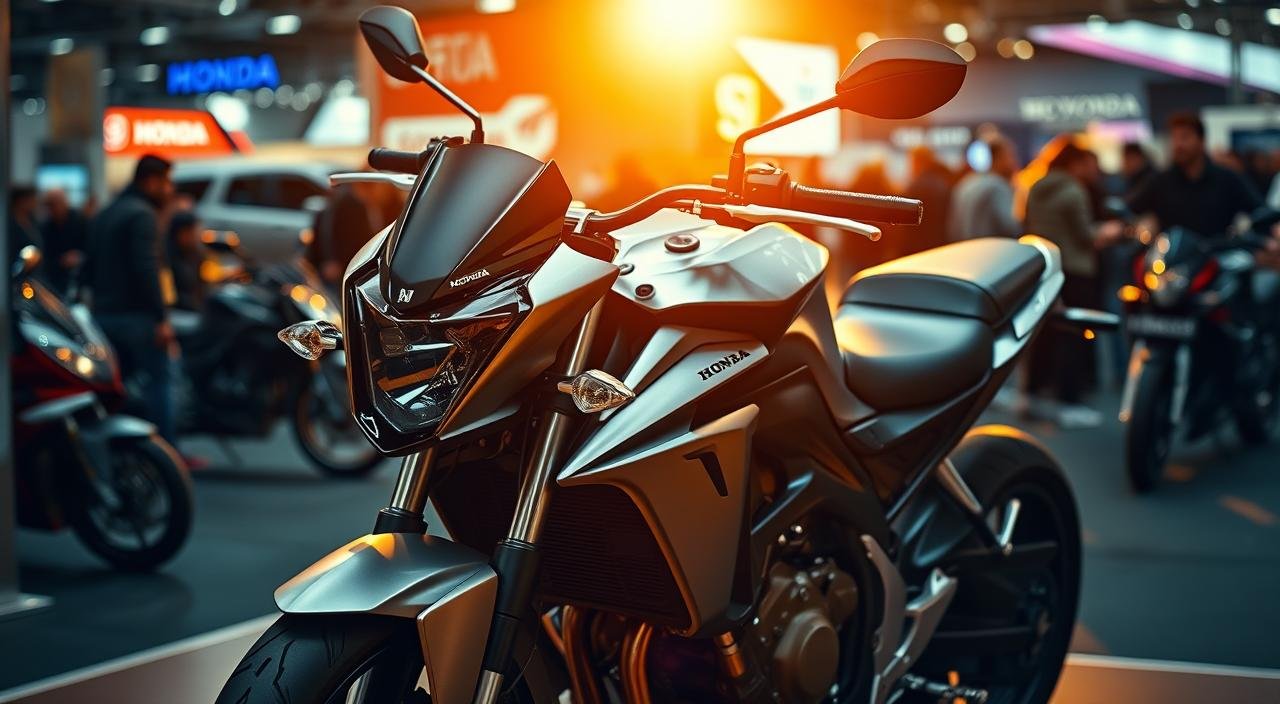
Nov
What if advanced motorcycle tech wasn’t just for high-end bikes? Honda surprised everyone at EICMA 2025 with a new strategy. They unveiled a lineup that could change the sport-touring world.
The Honda CB1000GT is the star, entering the 1000cc sport-touring scene for 2026. It’s not just another bike. Honda’s booth was full of surprises, showing more than just a new model.
Honda’s big move is adding E-Clutch tech to 500cc and 750cc bikes. This change shows a new way for makers to help riders. At EICMA 2025, Honda showed they want to make top features available to more people.
Indian riders have a lot to look forward to. Honda made these bikes with the Indian market in mind. They come with cool tech that makes every ride better.
Key Takeaways
- Honda CB1000GT debuts as a new 1000cc sport-touring motorcycle for 2026 model year
- E-Clutch technology expands to mid-capacity 500cc and 750cc motorcycles
- EICMA 2025 showcases Honda’s commitment to democratizing advanced riding features
- New lineup targets both beginner riders and experienced enthusiasts
- Indian market receives special attention with region-specific features
- Sport-touring segment gets a fresh competitor with innovative technology
Introduction to the Honda CB1000GT
The new Honda CB1000GT is set to change the sport touring scene in 2026. It’s a mix of a sport bike and a long-distance tourer. It comes with the latest tech and touring features that riders want.
Overview of the CB1000GT Model
The CB1000GT is based on the CB1000 Hornet SP but is made for touring. It has the same 1,000cc inline-four engine as its naked sibling. This engine makes 149.69 horsepower at 11,000 rpm, great for both fast rides and long trips.
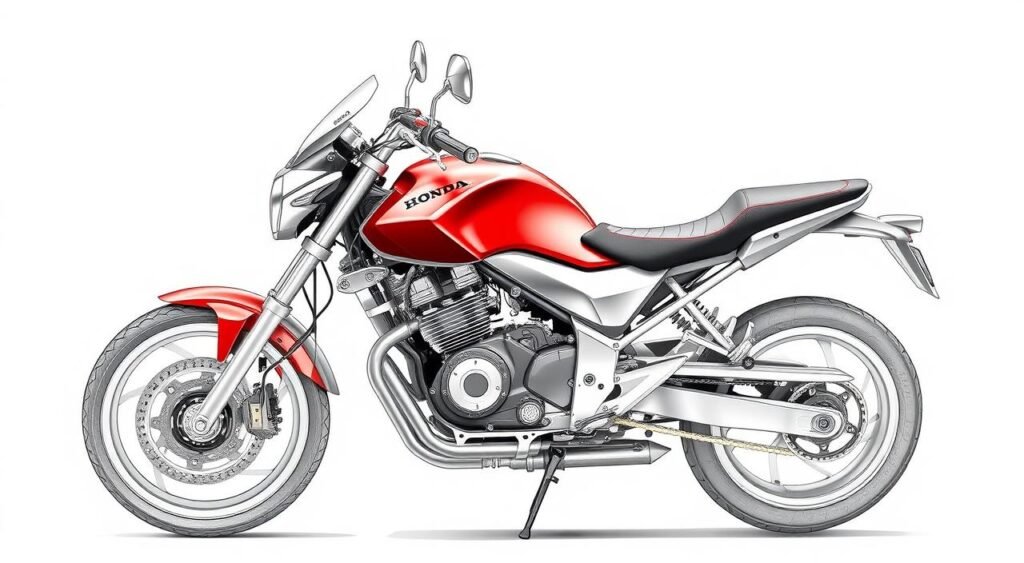
Key Features and Specifications
The Honda CB1000GT has advanced tech. It has a six-axis IMU for better traction and ABS. It also has ride-by-wire throttle and multiple riding modes for different situations.
| Feature | Specification |
|---|---|
| Engine Type | 1,000cc Inline-Four |
| Power Output | 149.69 HP @ 11,000 RPM |
| Electronics | Six-Axis IMU |
| Comfort Features | Heated Grips, Cruise Control |
| Storage | Side Panniers (Standard) |
Design and Aesthetics
The bike’s design is both practical and stylish. It has an adjustable windscreen and half-fairing for wind protection. The wide handlebar makes for a comfortable riding position, ideal for long rides. Honda also increased the fuel tank size for longer trips. Standard panniers make it ready for touring right out of the box.
Highlights from EICMA 2025
The Milan motorcycle show became a hub for the latest in engineering this year. Big names showed off their newest models, each aiming to break new ground. Thousands of fans came to see what the future holds for motorcycles.
Significant Reveals at the Event
CFMoto wowed everyone with their V4 SR-RR Prototype, boasting 210 horsepower and cool aerodynamics. Ducati hinted at their DesertX V2, and Zero Motorcycles unveiled the Lompico Concept. These reveals showed a focus on both power and making bikes more accessible.

Honda’s Commitment to Innovation
Honda focused on making high-end features available to more people. They showcased the V3R 900 E-Compressor Prototype, showing off their creative approach to forced induction. They aim to make these technology upgrades affordable for Indian riders.
Their E-Clutch system is now in the CB500 and CB750 lines. This move shows Honda’s dedication to making advanced tech available to everyone.
Reactions from Industry Experts
Experts praised the move towards semi-automatic transmissions and advanced tech. They say it’s a smart move to make city riding easier without losing out on fun on weekends. Specialists in India are excited about Honda’s plans, seeing a chance to change the premium bike market.
The Advancements in CB500 and CB750
The 2026 model year is a big deal for Honda technology. The brand is adding its semi-automatic transmission system to more bikes. This means five new models will have the E-Clutch option, making riding easier for everyone.
Introduction of the E-Clutch Technology
The E-Clutch system is a game-changer in motorcycle design. It’s coming to the 500s lineup, including the CBR500R, CB500 Hornet, and NX500. Riders can choose between manual and semi-automatic transmission.
The 750s segment also gets a boost with the CB750 Hornet and XL750 Transalp. Now, riders can pick their favorite way to ride without giving up anything.
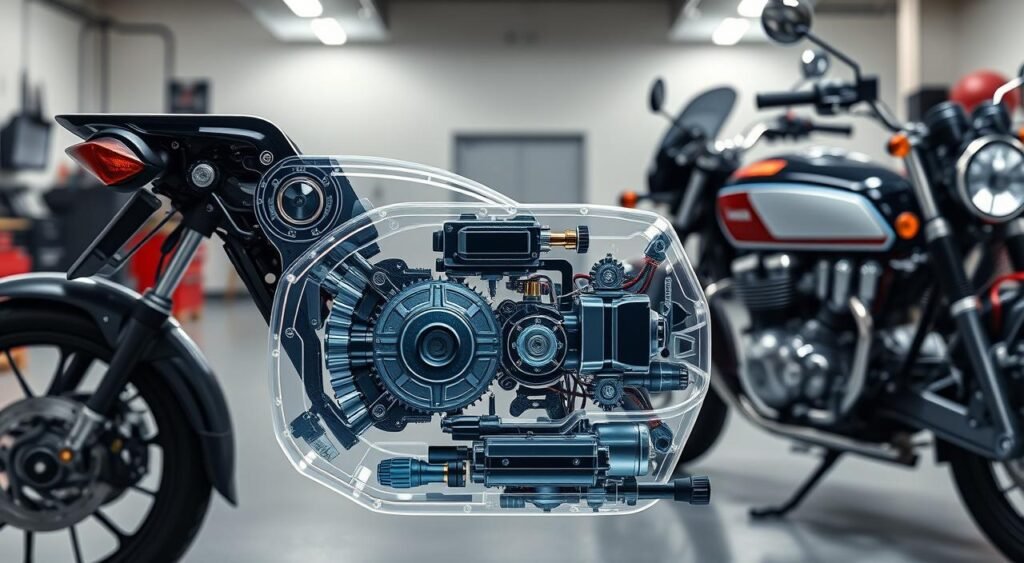
Benefits of E-Clutch in Riding Experience
Dealing with stop-and-go traffic is easier with the E-Clutch system. It makes gear changes automatic. This is great for new riders, as it makes learning to ride less hard.
The system keeps the traditional clutch lever for those who like manual control. It’s all about giving riders what they want.
Performance Enhancements in the 500s and 750s
The 500s and 750s get better gear transitions and fuel efficiency. Honda’s tech adjusts to different riding conditions. This means smoother rides in the city and on the highway.
Indian riders will see the E-Clutch versions of the 750s and NX500 early next year. They’ll come in phases, so stay tuned.
Market Positioning and Competitors
Honda is making a big move in the motorcycle market India with the CB1000GT and E-Clutch variants. They aim to attract both seasoned riders and newcomers. The CB1000GT is a sport-touring bike that competes in a crowded market.
Target Audience and Market Strategy
The CB1000GT is perfect for those who love touring but want comfort. Honda has priced it under Rs 14 lakh ex-showroom, making it a great deal. The E-Clutch technology on the CB500 and CB750 is great for city riders who hate dealing with clutches in traffic.
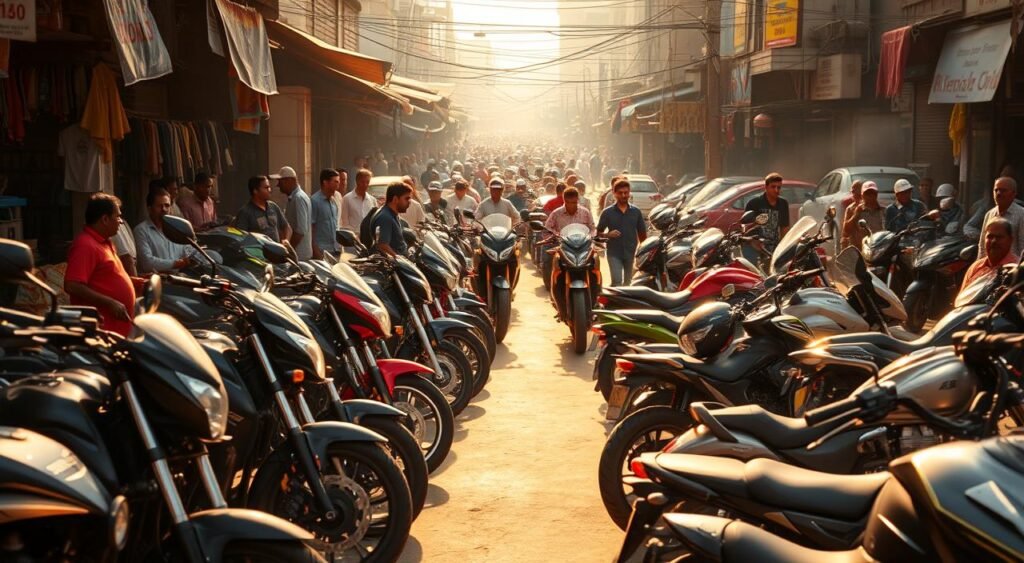
Competitor Analysis within the Segment
The sport-touring category has tough competitors. Our competition analysis shows who they are:
| Model | Engine Capacity | Expected Price Range | Key Strength |
|---|---|---|---|
| Honda CB1000GT | 998cc | Rs 13-14 lakh | Value positioning |
| Kawasaki Versys 1100 | 1099cc | Rs 15-16 lakh | Engine performance |
| Suzuki GSX-S1000GX | 999cc | Rs 14-15 lakh | Sport heritage |
| BMW S 1000 XR | 999cc | Rs 20-21 lakh | Premium features |
Expectations for Sales and Feedback
Honda’s reputation for reliability and the growing interest in semi-automatic systems look promising. The success of value-focused models in India shows buyers want good deals. The E-Clutch technology could change the game, making bikes more accessible to new riders.
Conclusion and Future Implications
Honda’s latest show at EICMA 2025 is a big deal for the Indian motorcycle market. The CB1000GT and updated E-Clutch models are more than just new bikes. They show Honda’s plan for the future.
These bikes mix touring fun with easy-to-use tech. They’re perfect for riders who want both power and ease.
Anticipated Launch Dates and Availability
The CB1000GT will hit the global market by 2026. But, Honda hasn’t shared when it will arrive in India yet. The E-Clutch CB750 and NX500 will debut in early 2025.
Honda will roll them out slowly. This lets dealers get ready and offer good service. Honda aims to launch these bikes before the busy riding season starts.
Long-term Impact on Honda’s Roadmap
Honda plans to use E-Clutch systems in more bikes soon. This move is inspired by the success of their 650cc twins. Honda wants to bring semi-automatic tech to more bikes.
This could change how Indian riders see clutching. It might make motorcycling more welcoming to new fans.
Final Thoughts on the 2025 Lineup
The 2025 lineup shows Honda’s dedication to innovation and tradition. The CB1000GT is for seasoned riders who want comfort and power. The E-Clutch models are great for city riders and weekend warriors.
As the Indian motorcycle market grows, Honda is ready. They’re bringing tech that makes riding better, not just different.
FAQ
When will the Honda CB1000GT be available for purchase?
The Honda CB1000GT is set to launch in 2026. Details for India are yet to be announced by Honda. It was unveiled at EICMA 2025 as part of Honda’s new lineup.
What engine powers the new CB1000GT and what are its performance specifications?
The CB1000GT has a 1,000cc four-cylinder engine. It’s the same engine as the Honda CB1000 Hornet SP. It produces 149.69PS at 11,000rpm, making it a strong sport-tourer.
Which Honda models are getting the E-Clutch technology upgrade for 2026?
Honda is adding E-Clutch semi-automatic technology to five models in 2026. The 500s include the CBR500R, CB500 Hornet, and NX500. The 750s are the CB750 Hornet and XL750 Transalp. All models will have E-Clutch as an option.
What are the key features included in the Honda CB1000GT?
The CB1000GT has many premium features. It includes ride-by-wire technology and a six-axis IMU for lean-sensitive electronics. It also has multiple riding modes, quickshifter, cruise control, heated grips, and panniers as standard.
It also has an adjustable windscreen, half-fairing design, and comfortable ergonomics for touring.
How does the E-Clutch system benefit riders, specially in the Indian market?
The E-Clutch system makes commuting easier. It’s great for stop-and-go traffic. It also keeps the traditional clutch lever for manual control when needed.
This upgrade is perfect for new riders in India’s busy cities.
What is the expected pricing for the CB1000GT in India?
The Honda CB1000GT is expected to cost under Rs 14 lakh ex-showroom. It will be priced higher than the Hornet 1000 but competitive with rivals.
When will the E-Clutch equipped 750cc models arrive in India?
Honda plans to introduce E-Clutch versions of the 750cc models and NX500 in India early next year. They will follow a phased introduction strategy.
What other significant motorcycles were revealed at EICMA 2025?
EICMA 2025 showed many innovations. The CFMoto V4 SR-RR Prototype has 210 HP and active aerodynamics. Ducati DesertX V2 preview and Zero Motorcycles Lompico Concept were also unveiled.
Honda’s V3R 900 E-Compressor Prototype was also showcased, highlighting the industry’s focus on advanced electronics and semi-automatic systems.
How does the CB1000GT differ from the standard Hornet platform?
The CB1000GT has bigger dimensions than the Hornet for better touring. It has a wider handlebar, larger fuel tank, and more comfortable riding posture. It also has a half-fairing design, making it a dedicated sport-tourer.
What are the latest features that make the CB1000GT suitable for touring?
The CB1000GT has features like cruise control and heated grips for comfort. It also has an adjustable windscreen and advanced electronics for different road conditions.
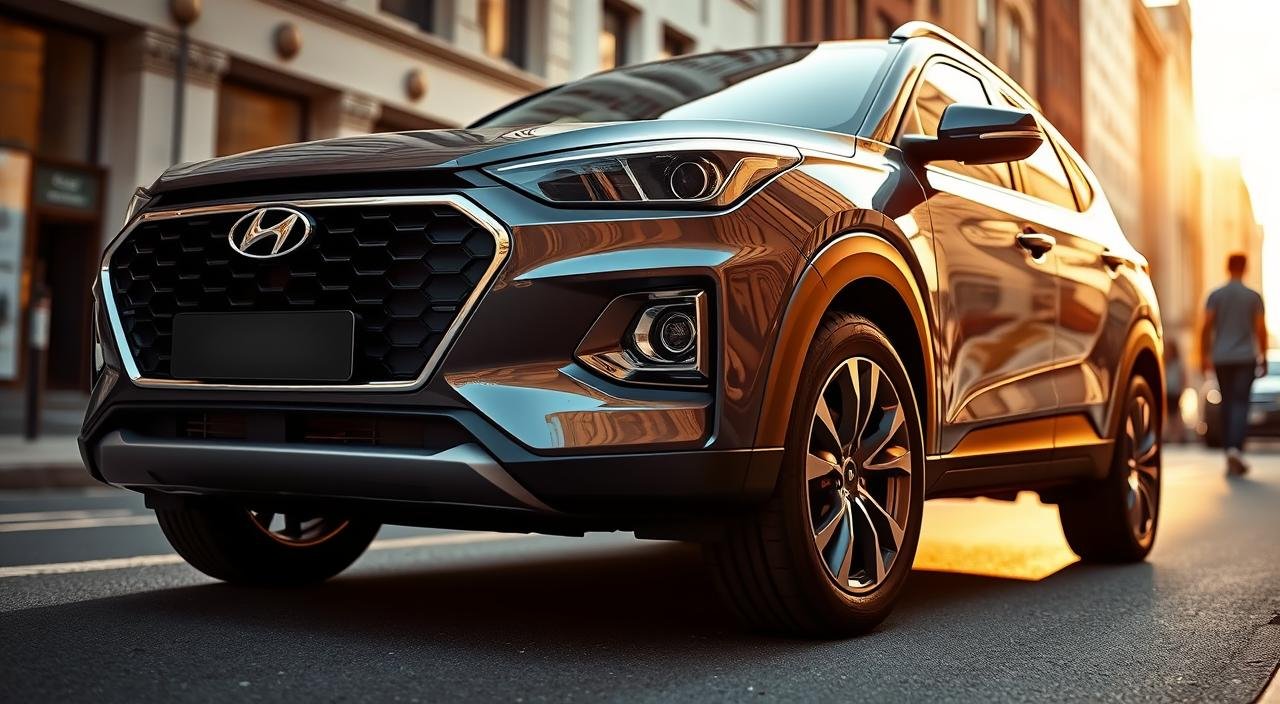
Nov
Can a small SUV really save on fuel and drive well? The 2025 Hyundai Venue says yes, surprising everyone in the small car market.
The 2025 Hyundai Venue’s fuel efficiency is impressive, tested in both city and highway driving. It’s set to hit the roads on November 4, 2025. It comes with five engine choices, priced from Rs. 7.90 lakh to Rs. 15.51 lakh ex-showroom.
The Hyundai Venue DCT’s dual-clutch transmission is a game-changer. It works smoothly with the 1.0-liter turbo engine. This 7-speed automatic is both efficient and powerful. The Venue offers a range of engines, including diesel options for those who prefer it.
Tests show the Hyundai Venue 2025’s 1.2-liter engine does well in city driving. The 1.0-liter turbo engines shine on highways, balancing power and fuel use. The Venue now has a simpler naming system, making it easier to choose a trim.
A new 1.5-liter turbo diesel engine with a 6-speed automatic is a big plus. It meets the demand for diesel-automatic combos in small SUVs. Each engine is designed for different needs, from saving money to seeking performance.
Key Takeaways
- The 2025 Hyundai Venue launches November 4, 2025 with five distinct powertrain options
- Price range spans Rs. 7.90 lakh to Rs. 15.51 lakh ex-showroom for Indian market
- The 7-speed DCT paired with 1.0L turbo petrol delivers surprising fuel efficiency
- New 1.5L turbo diesel-automatic variant joins the lineup with 6-speed torque converter
- HX nomenclature replaces previous variant naming for simplified identification
- Real-world mileage testing shows competitive figures across city and highway conditions
Overview of the 2025 Hyundai Venue
The 2025 Hyundai Venue Review shows a big change in the compact SUV world. It now has the latest tech and stylish looks for those on a budget. It also has bigger dimensions and features usually found in pricier cars, aiming to set a new standard in its class.
Key Features of the New Venue
The 2025 Venue is packed with cool tech in a small body. It has a huge 12.3-inch dual-screen display for both the infotainment and digital cluster. It also comes with wireless Apple CarPlay and Android Auto, and an 8-speaker Bose system for great sound.
It’s comfy too, with ventilated front seats, wireless charging, and a single sunroof. Safety is a big deal, with six airbags, ABS, and electronic stability control. The Level 2 ADAS package adds 16 advanced safety features, like a 360-degree camera and parking sensors.

Design and Aesthetics
The outside is sleek, with quad-beam LED headlamps and twin-horn LED DRLs. A dark chrome grille adds class, along with R16 alloy wheels and modern tail lamps. Inside, the design is upscale, with leatherette seats and unique crash pad details.
Comparison with Previous Models
| Specification | 2025 Model | Previous Model | Difference |
|---|---|---|---|
| Length | 3,995mm | 3,975mm | +20mm |
| Width | 1,800mm | 1,770mm | +30mm |
| Height | 1,665mm | 1,617mm | +48mm |
The Venue is now bigger, which means more room inside and a stronger presence on the road. This makes its fuel efficiency even more impressive, considering its size.
Testing Methodology for Mileage
The Hyundai Venue MPG Test uses strict methods to get accurate fuel economy data for India. Teams test fuel consumption in many ways. They check how well the car does in real-life driving situations.
Standardized Testing Procedures
The Hyundai Venue Performance Test starts with controlled tests. Technicians fill the tank and reset the trip meter before each test. The car goes on set routes at certain speeds.
City tests have 23 stops in 11 kilometers at 32 km/h. Highway tests keep speeds between 80-100 km/h for a long time.

Real-World Driving Conditions
Real road tests cover Mumbai traffic, Delhi highways, and Bangalore’s varied terrain. Drivers record fuel use in busy hours, rain, and heat. The Hyundai Venue MPG Test also compares with Maruti Brezza, Kia Sonet, and Tata Nexon under the same conditions.
Equipment Used for Measurement
Experts use calibrated flow meters and GPS for exact measurements. Digital fuel gauges track consumption to the milliliter. Onboard diagnostics check engine data.
| Testing Equipment | Function | Accuracy Level |
|---|---|---|
| OBD-II Scanner | Engine data monitoring | ±0.5% |
| Flow Meter FT-110 | Fuel consumption tracking | ±0.3% |
| GPS Logger GL-770 | Distance and speed verification | ±1 meter |
Performance Metrics of the Hyundai Venue
The 2025 Hyundai Venue impresses with its engine lineup. Each engine offers unique benefits for different drivers. The Hyundai Venue Petrol Engine Economy is known for its balance of power and fuel efficiency.
Engine Specifications
The Venue comes with three engine options for different needs. The base engine is a 1.2-liter petrol that makes 83 PS at 6,000 rpm and 115 Nm of torque at 4,200 rpm. It comes with a 5-speed manual transmission.
The 1.0-liter turbo petrol engine produces 120 PS at 6,000 rpm and 172 Nm of torque from 1,500 to 4,000 rpm. You can choose a 6-speed manual or the 7-speed DCT automatic transmission. The diesel engine is a 1.5-liter turbo that makes 116 PS at 4,000 rpm and 250 Nm of torque from 1,500 to 2,750 rpm.
| Engine Type | Power Output | Peak Torque | Transmission Options |
|---|---|---|---|
| 1.2L Petrol | 83 PS @ 6,000 rpm | 115 Nm @ 4,200 rpm | 5-speed Manual |
| 1.0L Turbo Petrol | 120 PS @ 6,000 rpm | 172 Nm @ 1,500-4,000 rpm | 6-speed Manual / 7-speed DCT |
| 1.5L Turbo Diesel | 116 PS @ 4,000 rpm | 250 Nm @ 1,500-2,750 rpm | 6-speed Manual / 6-speed AT |
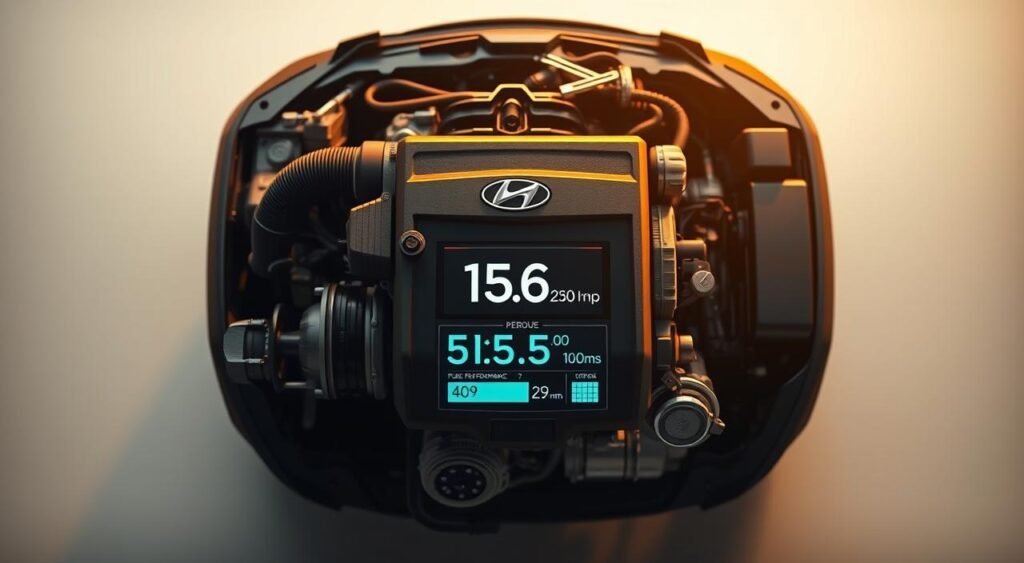
Acceleration and Top Speed
The turbo petrol engine moves smoothly through city streets. Its wide torque band makes driving easy. The automatic transmission shifts fast, helping with quick overtakes.
Handling and Ride Quality
The Venue is built with 71% hot-stamped and high-strength steel for great body rigidity. The N-Line variant has stiffer suspension and better steering. It also has a sportier exhaust sound.
These features make the Venue handle well in corners and stay comfortable on bumpy roads.
Mileage Statistics Explained
The 2025 Hyundai Venue has different fuel consumption rates for each engine. Knowing how transmission types and driving conditions affect fuel efficiency is key. This helps buyers choose the right Hyundai Venue Fuel Efficiency for their needs.
City vs. Highway Mileage
City driving, with its many stops and starts, uses more fuel than highway driving. The Venue’s petrol engines perform better on highways than in cities. For example, driving in Mumbai or Delhi uses more fuel than driving on highways between Bangalore and Chennai.
Petrol vs. DCT Performance
The Hyundai Venue DCT Surprises with great fuel efficiency. The 1.0L turbo petrol with DCT automatic gets 20.0 kmpl. This is better than the manual version, which gets 18.74 kmpl. This shows the DCT automatic can be more fuel-efficient than usual.
Overall Efficiency Ratings
Each engine option has its own benefits for different driving needs. The diesel manual is the most efficient. The DCT automatic balances performance with fuel economy.
| Engine Type | Transmission | Mileage (kmpl) |
|---|---|---|
| 1.2L Petrol | Manual | 18.05 |
| 1.0L Turbo Petrol | Manual | 18.74 |
| 1.0L Turbo Petrol | DCT | 20.0 |
| 1.5L Diesel | Manual | 20.99 |
| 1.5L Diesel | Automatic | 17.90 |
DCT Transmission: What to Expect
The 7-speed dual-clutch transmission in the 2025 Hyundai Venue brings racing-inspired technology to everyday driving. It pairs with the 1.0-liter turbocharged petrol engine, delivering performance and efficiency. Drivers can expect fuel economy reaching 20.0 kilometers per liter and automatic gear changes.
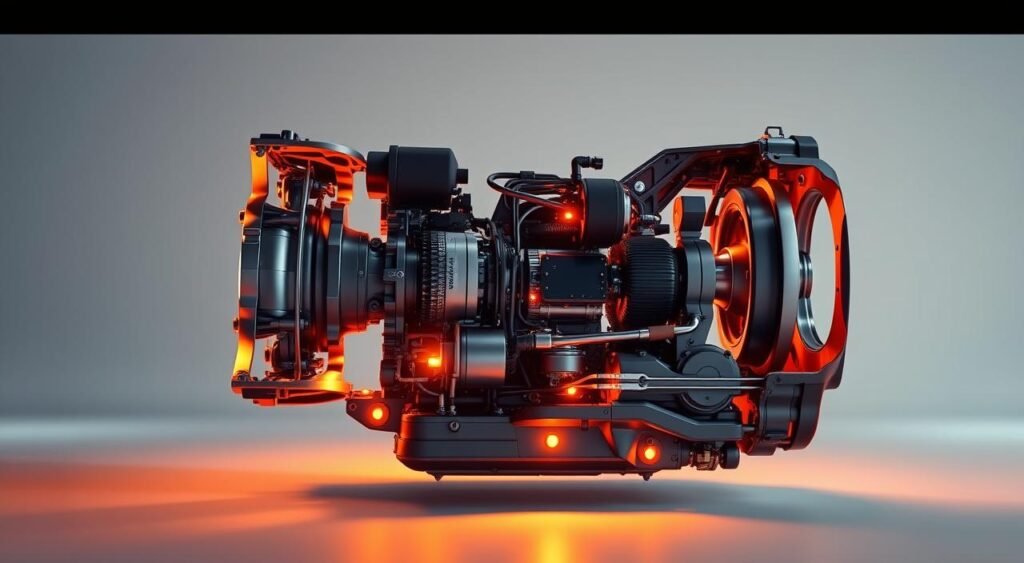
Benefits of Dual Clutch Transmission
The DCT system uses two separate clutches for odd and even gears. This design pre-selects the next gear while the current one stays engaged. The result is lightning-fast shifts that take just milliseconds to complete.
During the Hyundai Venue Performance Test, the transmission showed seamless power delivery. It avoids the typical torque interruption found in regular automatics.
Paddle shifters behind the steering wheel give drivers manual control when desired. Multiple drive modes and traction control settings adapt the transmission’s behavior to different road conditions. These features come at a premium of Rs. 92,500 to Rs. 1.04 lakh over manual variants.
Smoothness and Responsiveness
The DCT delivers immediate throttle response that feels more connected than traditional automatics. Gear changes happen so quickly that passengers barely notice shifts during acceleration. The system maintains smooth operation in stop-and-go traffic while providing sporty performance on open roads.
Differences from Conventional Transmissions
Unlike torque converter automatics, the DCT eliminates power loss through direct mechanical connection. Manual transmissions require driver input and clutch operation, while the DCT handles everything automatically. CVT systems use belts and pulleys, but the DCT uses actual gears for better acceleration feel and durability.
Real-World Mileage Results
The 2025 Hyundai Venue petrol mileage tested in real-world conditions shows great results. The DCT variant gets nearly 20.0 kmpl in mixed driving. This beats the manual’s 18.74 kmpl, making the automatic a great choice for daily drives.
Test Drives in Various Conditions
The Hyundai Venue MPG test was done in different driving situations. In the city, the DCT got around 17.8 kmpl. On highways, it reached 21.2 kmpl. The manual got 16.5 kmpl in the city and 19.8 kmpl on highways.
Stop-and-go traffic lowered efficiency by about 15% for both transmissions during peak hours.
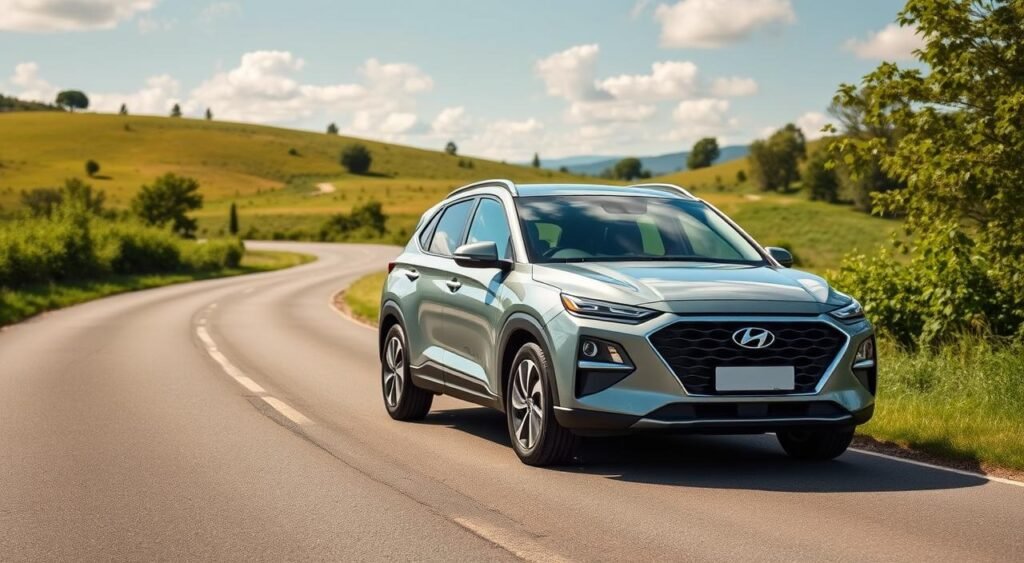
Comparisons with Competitors
The turbo petrol Venue is similar to the Kia Sonet but trails leaders. The Maruti Fronx and Toyota Taisor get 21.50 kmpl with manuals and 20.01 kmpl with automatics. Diesel Venue’s 20.99 kmpl is less than Tata Nexon’s 23.23 kmpl manual and 24.08 kmpl automatic.
Mahindra XUV 3XO diesel gets 20.0 kmpl with 300Nm torque, beating Venue.
User Experiences and Feedback
Owner reports match the tested mileage figures for the 2025 Hyundai Venue petrol. Most drivers see 18-19 kmpl in mixed conditions with careful driving. The DCT’s smooth shifts help it beat expectations.
Smaller engine rivals like Nissan Magnite (19.40 kmpl) and Renault Kiger (19.83 kmpl) offer similar efficiency, despite being smaller.
Factors Affecting Fuel Efficiency
The Hyundai Venue’s fuel efficiency depends on more than just its engine. Knowing these factors helps drivers get the most out of their car. Small changes in how you drive can make a big difference over time.
Driving Habits and Techniques
Your driving style affects the Hyundai Venue’s fuel economy. Fast starts and hard braking can cut mileage by up to 30 percent in the city. Driving smoothly and keeping a steady speed is best.
For highway driving, aim for speeds between 80 and 90 kilometers per hour. This is where the engine works most efficiently. The HX10 turbo petrol model has a feature that saves fuel at traffic stops. It turns off the engine at red lights and starts again when you’re ready to move.
Regular maintenance is also key. Keeping air filters clean and changing oil on time helps the engine run well.
Weather and Environmental Influences
Weather can impact the Hyundai Venue’s fuel efficiency more than you might think. Using the air conditioner in the city can lower economy by 10 to 15 percent. Cold weather makes the engine oil thicker and takes longer to warm up.
Hot weather makes the cooling system work harder. Wind resistance also increases fuel use at high speeds, more so during monsoon seasons.
Weight and Cargo Considerations
Every extra 100 kilograms of weight can reduce the Hyundai Venue’s fuel economy by about 2 percent. The tire pressure monitoring system helps keep fuel use down by preventing waste from underinflated tires. Adding roof carriers or external accessories increases drag, affecting efficiency even when they’re empty.
Future of the Hyundai Venue Lineup
The subcompact SUV market is changing fast, and Hyundai is making big plans for the Venue lineup. They aim to bring new features that will make driving better and safer. These updates are set to make the Venue even more exciting for drivers.
Anticipated Model Updates
The 2025 Hyundai Venue Review shows big safety upgrades. Hyundai SmartSense Level 2 ADAS will add 16 advanced safety features. These include Forward Collision-Avoidance Assist and Smart Cruise Control.
Driver Attention Warning and Parking Collision-Avoidance Assist are also part of the package. This makes the Venue one of the safest in its class.
Expansion of Engine Options
Performance lovers will enjoy the N-Line variant. It offers a sportier driving experience with better suspension and exhaust systems. Hyundai is also looking into hybrid options to meet global green goals.
Remote engine start is now standard, making life easier in India’s weather.
New Technologies on the Horizon
Future updates will focus on connected car tech. Over-the-air updates will keep infotainment systems current without needing a dealership visit. Telematics connectivity will also become standard, allowing for smartphone integration and vehicle monitoring.
Customer Reviews and Feedback
Early adopters of the 2025 Hyundai Venue Petrol Mileage Tested share real-world insights. They talk about their experiences with this compact SUV. Their feedback is valuable for understanding its performance and usability in daily life.
User Ratings on Performance
Owners of the turbo petrol DCT variant are very pleased. They say the fuel efficiency is better than expected. In the city, they get 18-19 kmpl, and on highways, it’s 21-22 kmpl.
Diesel manual transmission owners also report high satisfaction. They get 19-20 kmpl in various driving conditions. The DCT transmission is praised for its smooth shifts and quick acceleration in traffic.
Reliability and Satisfaction Levels
Customer satisfaction focuses on three main points in this Hyundai Venue Review:
- Spacious interior thanks to increased dimensions
- Comprehensive safety features in most variants
- Competitive pricing starting at Rs. 7.90 lakh
Reliability scores are consistently high across different trim levels. Owners value the build quality and low maintenance needs in the first few months.
Common Praise and Criticism
The 2025 Hyundai Venue Petrol Mileage Tested models get a lot of praise. But, some features are a point of contention. Budget-conscious buyers are upset by missing amenities in lower variants.
The lack of TPMS, automatic climate control, and height-adjustable driver seats in lower trims is a letdown. Manual transmission buyers are also frustrated. They say the electronic parking brake is only available in automatic variants.
Conclusion: The 2025 Hyundai Venue’s Value
The 2025 Hyundai Venue is a great choice for those on a budget. It offers good fuel economy, making it perfect for city driving. Prices range from Rs. 7.90 lakh to Rs. 15.51 lakh, fitting various budgets.
Summary of Mileage Findings
The Hyundai Venue 2025 shows great mileage results. The DCT model gets 20.0 kmpl, beating the manual’s 18.74 kmpl. This makes the DCT great for city driving.
Overall Assessment of Performance
The Venue competes with the Tata Nexon and Maruti Fronx. Nexon has better diesel efficiency, and Fronx has better petrol economy. But the Venue offers a good balance of performance and features.
The HX5 and HX6 variants are the best value. They offer practical features at a good price. The N-Line variant is pricier but adds a sporty touch.
Final Thoughts on Purchase Considerations
The 2025 Venue is worth its price with top safety features and tech. The DCT model is a surprise hit for city drivers. It’s efficient and automatic.
When choosing, think about your driving habits. The Venue’s mileage varies by variant, depending on your needs.
FAQs About the 2025 Hyundai Venue
Many people wonder about the 2025 Hyundai Venue and its dual-clutch transmission. They often ask about DCT reliability, service costs, and expected mileage. The Hyundai Venue’s automatic transmission has shown to be reliable in India, with thousands of units sold.
Proper maintenance is key for long-term performance. Service costs are competitive, with visits costing between Rs. 3,000 to Rs. 5,000 at authorized centers.
Common Queries Addressed
DCT maintenance needs special fluid changes every 40,000 kilometers. This costs a bit more than regular fluid changes. The warranty covers 3 years unlimited kilometers, with options for up to 5 years.
People ask about the Hyundai Venue’s performance in India. The DCT variant gets 16-18 km/l in mixed driving. It handles stop-and-go traffic well in Indian cities.
Troubleshooting Fuel Efficiency Issues
Low fuel efficiency can be due to several reasons. Check tire pressure, which should be 33 PSI for best performance. A clogged air filter can cut efficiency by up to 10%.
Driving habits also affect mileage. Aggressive driving and sudden braking can lower it by 20-30%. Using the right fuel grade is important, as the Venue’s engine works best with regular unleaded petrol.
Where to Learn More About the Venue
Authorized Hyundai dealerships across India offer test drives and comparisons. The official Hyundai India website has a car configurator, online booking, and EMI calculator. Spare parts are easily available due to local manufacturing in Chennai.
CarDekho and CarWale provide user reviews and specs. YouTube channels like Autocar India and PowerDrift have detailed reviews of the Venue’s automatic transmission variants.
FAQ
What is the actual mileage of the 2025 Hyundai Venue DCT variant?
The Hyundai Venue DCT gets an impressive 20.0kmpl, beating the manual’s 18.74kmpl. Real tests show it gets 18-19kmpl in the city and 21-22kmpl on highways. This makes it surprisingly more fuel-efficient than the manual.
How does the Hyundai Venue fuel efficiency compare to competitors?
The 2025 Hyundai Venue’s turbo petrol matches the Kia Sonet but trails the Maruti Fronx/Taisor. The diesel manual’s 20.99kmpl is less than the Tata Nexon’s 23.23kmpl manual. The Mahindra XUV 3XO diesel has better torque and fuel efficiency.
What are the key features of the Hyundai Venue automatic transmission?
The Hyundai Venue automatic has a 7-speed dual-clutch technology with the 1.0L turbo petrol engine. It offers quick shifts and seamless power without torque loss. It also has paddle shifters, drive modes, and traction control, priced at a premium of Rs. 92,500 to Rs. 1.04 lakh over manual.
What is the price range for the 2025 Hyundai Venue?
The 2025 Hyundai Venue costs from Rs. 7.90 lakh to Rs. 15.51 lakh ex-showroom. It offers five powertrain options, including a new 1.5L turbo diesel-automatic. The best value is in the HX5 and HX6 variants.
How reliable is the Hyundai Venue petrol engine economy?
The Hyundai Venue petrol engine economy varies by variant. The 1.2L normal petrol gets 18.05kmpl, while the 1.0L turbo petrol gets 18.74kmpl with manual and 20.0kmpl with DCT. Driving style, air conditioning, and regular maintenance affect efficiency.
What are the standout features in the Hyundai Venue 2025 mileage performance test?
The Hyundai Venue 2025 mileage test showed the DCT variant’s surprising efficiency. It achieves near-claimed figures in mixed conditions. The diesel manual is most efficient at 20.99kmpl for high-mileage users, while the diesel automatic gets 17.90kmpl. Real-world testing confirmed these figures.
How does the Hyundai Venue MPG test compare between city and highway driving?
The Hyundai Venue MPG test shows city driving reduces efficiency by 15-20% compared to highways. The DCT variants get 21-22kmpl on highways and 18-19kmpl in the city. The idle start-stop technology in HX10 turbo petrol variants improves city efficiency.
What advanced features come with the 2025 Hyundai Venue?
The 2025 Hyundai Venue has impressive features like a 12.3-inch dual-screen display and wireless Apple CarPlay and Android Auto. It also has an 8-speaker Bose sound system, ventilated front seats, and Level 2 ADAS with 16 advanced safety features. It has 71% hot-stamped steel for crash safety and includes six airbags, 360-degree camera, and electronic stability control as standard.
What maintenance is required for the Hyundai Venue performance test results?
To keep the Hyundai Venue performing well, DCT variants need special transmission fluid changes. All variants benefit from regular tire pressure monitoring, air filter maintenance, and proper fuel use. Warranty coverage includes standard 3-year/unlimited kilometer protection with extended options available through authorized Hyundai dealerships.

Nov
Can you find the perfect mix of diesel efficiency, automatic ease, and SUV features without spending too much in India’s car market?
Finding the best budget diesel SUVs is now easier. Car makers have added great features to affordable models. The top 5 diesel automatic SUVs under ₹15 lakh offer amazing fuel economy and strong diesel power.
Indian buyers have found their solution in these budget torque kings. They make daily commutes easier with automatic transmissions. Models like the Tata Nexon, Kia Sonet, and Hyundai Venue offer diesel power and automatic shifts at affordable prices for middle-class families.
The demand for diesel automatic SUVs under ₹15 lakh is growing. These cars are great for long trips because of their diesel efficiency. Automatic transmissions also make city driving less tiring. These vehicles show that you can have both quality and value in India’s market.
Key Takeaways
- Diesel automatic SUVs deliver 17-24 kmpl fuel efficiency for lower running costs
- Tata Nexon, Kia Sonet, and Hyundai Venue lead the affordable diesel automatic segment
- Strong torque output makes these SUVs ideal for highway cruising and city driving
- Automatic transmissions reduce driver stress in heavy traffic conditions
- Budget torque kings combine diesel economy with SUV practicality under ₹15 lakh
- Best budget diesel SUVs offer modern features without premium pricing
Introduction to Diesel Automatic SUVs
The Indian car market has seen a big change towards diesel automatic SUVs. These cars use diesel engines for better fuel use and automatic transmissions for ease. They are perfect for city driving and long trips, balancing cost and comfort well.
Why Choose Diesel Over Petrol?
Diesel engines use less fuel, with cars like the Hyundai Venue and Kia Sonet getting up to 24 kilometers per liter. They have more power for driving on highways and carrying heavy loads. With regular care, diesel engines can last about 800,000 kilometers, much longer than petrol ones.
The Rising Popularity of SUVs
Compact SUVs have become very popular in India. They offer a high driving position, strong build, and lots of space for cargo. This has led to more affordable Diesel Automatic SUVs for Indian buyers.
Understanding Automatic Transmissions
Modern automatic gearboxes make driving easier, as you don’t need to press the clutch. There are two main types:
- AMT (Automated Manual Transmission) – A budget-friendly choice in affordable models
- Torque Converter – Offers a smoother ride in higher-end cars
These transmissions make driving easier and keep the fuel savings of diesel engines.
Criteria for Selection
Choosing the right diesel automatic SUV is all about finding the right mix of price, performance, and features. This ensures buyers get the best value for their money. When looking at Top Diesel SUVs Under 15 Lakh, we focus on what matters most to Indian buyers.
Budget Considerations
Diesel automatic SUVs start at ₹10 lakh and go up to ₹15 lakh ex-showroom. This range offers great options with different features and abilities. Buyers should compare on-road prices, which include extra costs like registration and insurance. Many dealerships also offer financing with good interest rates, making these Budget-friendly Diesel SUVs affordable for middle-class families.
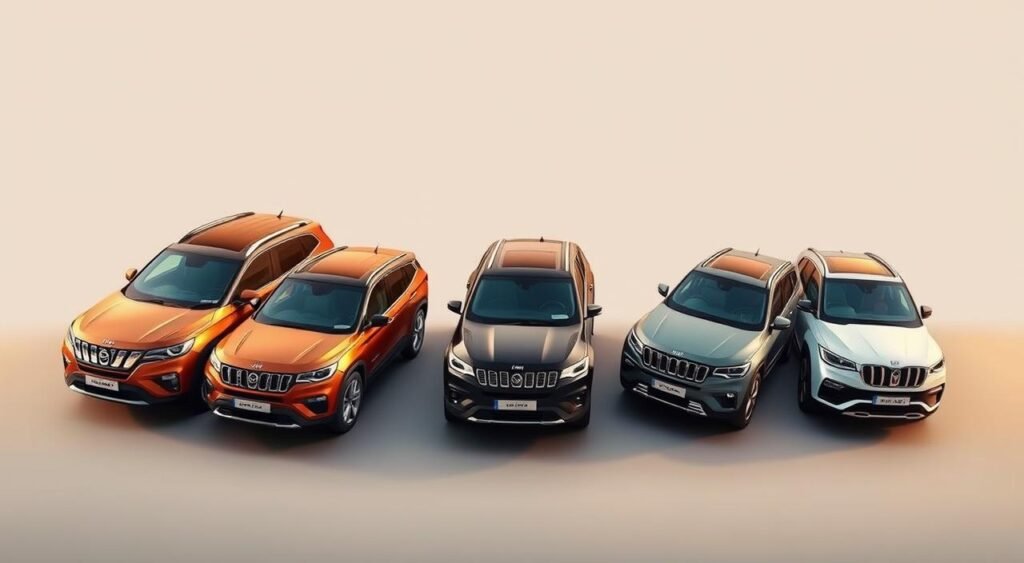
Performance Metrics
Most diesel SUVs in this range have 1.5-liter engines. These engines give strong torque for everyday driving. They make 100-115 horsepower and 250-300 Nm of torque. Plus, they’re fuel-efficient, getting 17-24 kilometers per liter depending on how you drive.
| Performance Aspect | Typical Range | Ideal for |
|---|---|---|
| Engine Capacity | 1.5L Diesel | City & Highway |
| Power Output | 100-115 HP | Daily Commute |
| Torque | 250-300 Nm | Hill Climbing |
| Fuel Economy | 17-24 kmpl | Long Distance |
Features and Comfort
Modern diesel SUVs come with advanced tech and safety features. They have 8-10.25 inch touchscreens with Android Auto and Apple CarPlay. Safety is key, with six airbags in most models. The top models have features like ventilated seats and automatic climate control.
The suspension systems are designed for Indian roads. They offer a smooth ride over rough roads and stability at high speeds.
SUV #1: Tata Nexon
The Tata Nexon is a standout among Top SUVs under ₹15 Lakh in India. It’s known for its safety, practical features, and strong diesel engine. This makes it a great choice for those watching their budget.
The Nexon has a 1.5-liter Revotorq diesel engine. It produces 110 horsepower and 260 Nm of torque. It comes with a 6-speed AMT gearbox, making it very fuel-efficient. It gets about 24 kmpl on highways.
The SUV also scored a perfect 5-star rating in Global NCAP crash tests. This sets a new safety standard in its class.
Key features include:
- 7-inch touchscreen infotainment system with Apple CarPlay and Android Auto
- Dual airbags and ABS with EBD as standard
- Automatic climate control
- Projector headlamps with LED DRLs
- 350 liters of boot space
The Nexon starts at ₹10.5 lakh for the diesel automatic variant. It has a bold design with a unique humanity line. The interior is comfortable for five adults, with premium upholstery and plenty of legroom. The build quality is solid, with minimal gaps and sturdy materials.
Tata Nexon Detailed Analysis
The Tata Nexon is a top pick among the Top 5 Diesel Automatic SUVs Under ₹15 Lakh. It’s known for its solid engineering and great value. This compact SUV offers strong performance and useful features, making it a top choice in India.
The Nexon has a 1.5-liter Revotorq diesel engine and an AMT transmission. It gets between 23.23 and 24.08 kilometers per liter. Starting at ₹11.70 lakh for the Pure Plus Diesel AMT trim, it’s a budget-friendly option. Prices go up to ₹15.60 lakh ex-showroom for the higher trims.
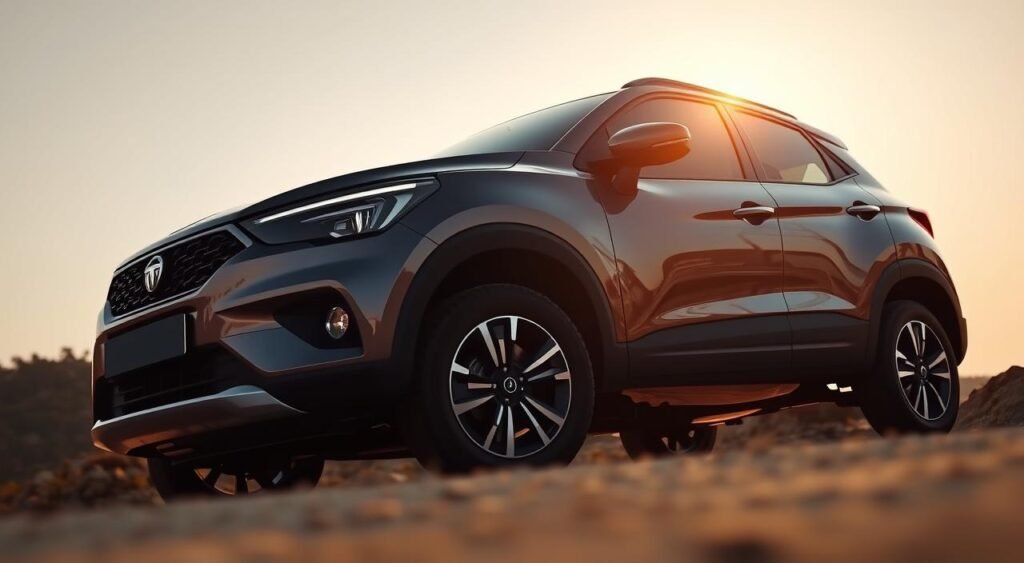
Inside, the Nexon has a 7-inch touchscreen with Android Auto and Apple CarPlay. Its suspension system is great at smoothing out bumps, making rides comfy for everyone. The diesel engine runs smoothly, with less noise and vibration than many other cars.
| Specification | Details |
|---|---|
| Engine | 1.5L Revotorq Diesel |
| Transmission | AMT Automatic |
| Mileage | 23.23-24.08 kmpl |
| Starting Price | ₹11.70 lakh |
| Safety Rating | 5-Star Global NCAP |
The Nexon is also very safe, with a 5-star Global NCAP rating. This makes it one of the safest cars in its class. It’s a great choice for families who want a safe and affordable vehicle.
SUV #2: Kia Sonet
The Kia Sonet is a standout in the Affordable Diesel SUVs category. It combines style with substance perfectly. Its turbocharged diesel engine makes 115 horsepower and 250 Nm of torque. The 6-speed automatic transmission makes shifting smooth and keeps fuel efficiency high.
Kia calls the Sonet a Budget Torque King because of its many features. Inside, you’ll find a 10.25-inch touchscreen with wireless Apple CarPlay and Android Auto. It also has ventilated front seats, ambient lighting, and a Bose sound system that’s a step above the rest.
| Specification | Kia Sonet Diesel AT |
|---|---|
| Engine | 1.5L CRDi Diesel |
| Power Output | 115 HP @ 4,000 rpm |
| Torque | 250 Nm @ 1,500-2,750 rpm |
| Transmission | 6-Speed Automatic |
| Fuel Economy | 18.2 km/l |
| Price Range | ₹11.85 – ₹14.65 Lakh |
The Sonet has six airbags, electronic stability control, and hill-start assist for safety. It got a 3-star Global NCAP safety rating. Its connected car technology offers over 60 features through the UVO Connect app. You can start the engine remotely and track your vehicle.
Kia Sonet: A Top Diesel SUV Under 15 Lakh
The Kia Sonet is a standout among Top Diesel SUVs Under 15 Lakh. It has a 1.5L CRDi engine that gets 24.1 kmpl. This turbocharged powerplant is similar to the Hyundai Venue but has a sharper throttle and smoother power in the city.

The automatic version starts at ₹13.39 lakh for the HTX Diesel AT trim. This makes it a great deal among Best Budget Diesel SUVs. The GTX Plus variant goes up to ₹15.60 lakh, with features that match pricier cars. The 6-speed automatic gearbox and diesel engine make for a smooth drive, perfect for city and highway.
| Variant | Price (₹ Lakh) | Key Features |
|---|---|---|
| HTX Diesel AT | 13.39 | 8-inch touchscreen, rear camera, cruise control |
| HTX Plus Diesel AT | 14.29 | Sunroof, LED headlamps, wireless charging |
| GTX Plus Diesel AT | 15.60 | 10.25-inch display, Bose audio, ventilated seats |
The Sonet is great for city streets and highway tours. Its small size and powerful diesel engine make it perfect for both new and experienced drivers. It offers great fuel efficiency without losing performance.
SUV #3: Hyundai Venue
The Hyundai Venue is a top pick for those looking for a budget-friendly diesel SUV. It has a compact design and great fuel economy. It’s perfect for city driving and is priced under ₹15 lakh.
The Venue’s 1.5-liter CRDi diesel engine makes 115 PS and 250 Nm of torque. It comes with a 6-speed automatic transmission. This makes driving in the city smooth and highway trips okay. It also gets 23.7 kmpl, which is very fuel-efficient.
What makes the Venue special includes:
- 8-inch touchscreen infotainment system with wireless Android Auto and Apple CarPlay
- Ventilated front seats for comfort during Indian summers
- BlueLink connected car technology with 60+ features
- Six airbags and electronic stability control in higher variants
- Air purifier with AQI display
The Venue is easy to park and move around in tight spaces. It has a 352-liter boot for weekend trips. The build quality is solid, and the fit and finish are good. The diesel automatic starts at about ₹12.35 lakh (ex-showroom), making it a great choice for first-time SUV buyers.
Hyundai Venue Feature Breakdown
The Hyundai Venue is a standout in the Affordable Diesel SUVs market. It has a 1.5-liter diesel engine that gets 24.2 kilometers per liter. This makes it great for daily drives, combining economy with good performance.
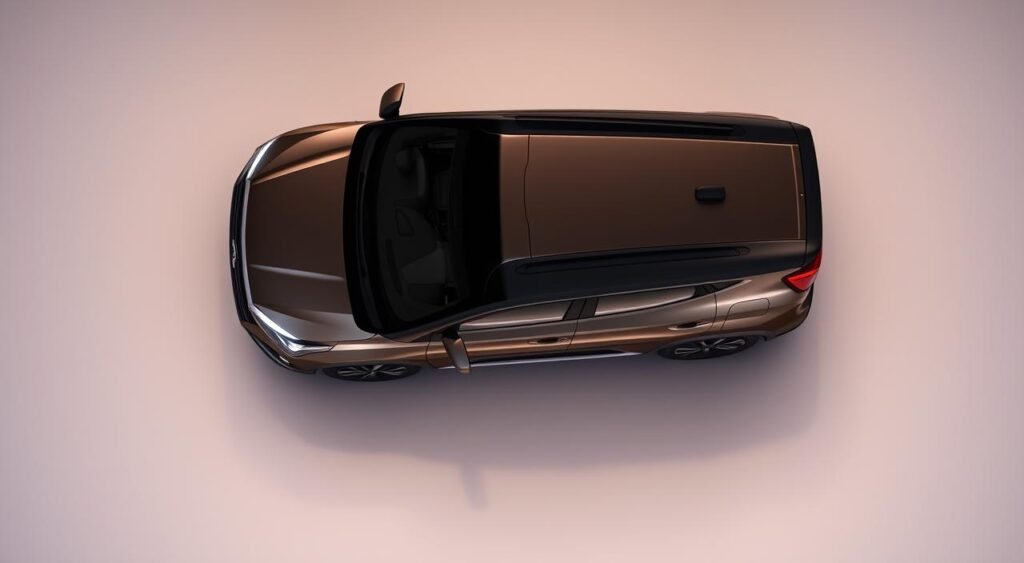
The Venue’s price ranges from ₹10.80 lakh to ₹13.53 lakh. It’s in the Top 5 Diesel Automatic SUVs Under ₹15 Lakh list. But, it only has manual transmission in diesel models, which might be a drawback for some.
The interior boasts an 8-inch touchscreen with Hyundai’s BlueLink tech. This system offers tracking, remote control, and emergency help. It adds to the car’s convenience and safety.
Drivers in the city will love the Venue’s size. It’s 3,995mm long and 1,770mm wide. These dimensions make parking and city driving easy. The light steering and stable suspension also help during long drives.
The diesel engine is perfect for city driving. It has strong torque at low RPMs, so you don’t need to shift gears often. This makes the Venue a great choice for families needing easy, stress-free daily rides.
SUV #4: Mahindra XUV300
The Mahindra XUV300 is a top pick under ₹15 Lakh. It’s known for its safety and solid build. It got a 5-star Global NCAP safety rating, making it very safe.
The diesel automatic version has a 1.5-liter turbocharged engine. It makes 115 horsepower and 300 Nm of torque.
The XUV300 diesel automatic has a 6-speed AMT gearbox. This setup makes shifting gears smooth and saves fuel, about 20 kmpl. It’s great for both highway and city driving.
| Specification | Details |
|---|---|
| Engine | 1.5L Diesel Turbo |
| Power Output | 115 HP |
| Torque | 300 Nm |
| Transmission | 6-Speed AMT |
| Fuel Economy | 20 kmpl |
| Safety Rating | 5-Star Global NCAP |
| Price Range | ₹12.5 – ₹14.5 Lakh |
It comes with cool features like dual-zone climate control and seven airbags. It also has front and rear disc brakes and a sunroof. The interior is spacious, with lots of knee and shoulder room.
The 8-inch touchscreen supports Android Auto and Apple CarPlay. It’s a great choice for those who want safety and comfort.
Mahindra XUV300 Performance Overview
The Mahindra XUV300, now succeeded by the XUV 3XO, is a top pick among Best Budget Diesel SUVs. It has a strong 1.5-liter diesel engine. This SUV is fuel-efficient, getting 17 to 20.6 kilometers per liter.
The AMT automatic variants cost between ₹11.96 lakh and ₹14.70 lakh ex-showroom. This makes it a great deal among Top Diesel SUVs Under 15 Lakh. It has 115 horsepower and 300 Nm of torque, giving it strong acceleration and confident highway performance.
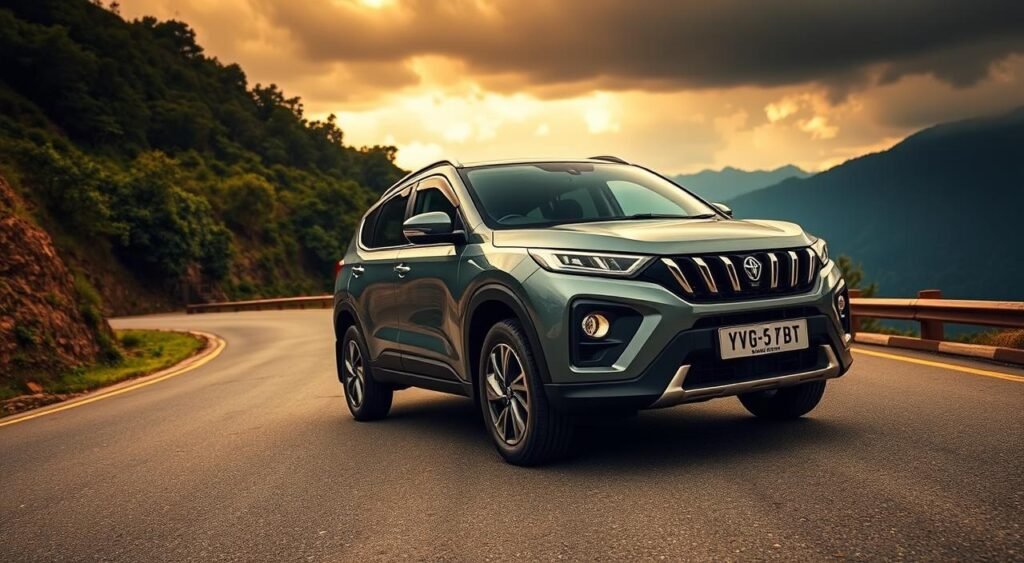
Safety features include multiple airbags, electronic stability control, and hill hold assist. The interior is practical and comfortable for five passengers. It also has a 7-inch touchscreen infotainment system with Android Auto and Apple CarPlay.
| Performance Metrics | Specifications |
|---|---|
| Engine Displacement | 1497 cc |
| Power Output | 115 HP @ 3750 rpm |
| Peak Torque | 300 Nm @ 1500-2500 rpm |
| Transmission Type | 6-speed AMT |
| Fuel Tank Capacity | 42 liters |
Mahindra’s traditional ruggedness meets modern refinement in the XUV300. It stands out in build quality and ride comfort. This makes it a top choice for those looking for reliable Top Diesel SUVs Under 15 Lakh in India.
SUV #5: Ford EcoSport
The Ford EcoSport is a standout among Diesel Automatic SUVs India offers today. Even though Ford left India in 2021, the EcoSport is available through dealers and the used car market. It won Indian hearts with its reliability and smart design.
The EcoSport has a 1.5-liter TDCi diesel engine. It makes 100 PS of power and 215 Nm of torque. With a 6-speed automatic transmission, it drives smoothly in the city and confidently on highways. It gets about 17 km/l, which is good for its class.
What made the EcoSport popular includes:
- SYNC 3 infotainment system with 8-inch touchscreen
- Six airbags in higher variants
- Electronic stability program
- Traction control system
- Hill launch assist
- Rear parking sensors with camera
The EcoSport is 3,998mm long and has 352 liters of boot space. Its 200mm ground clearance is great for Indian roads. The interior has quality materials and lots of storage. Rear seat passengers get enough legroom and headroom for a sub-4-meter SUV.
Used EcoSport diesel automatics now cost between ₹8 lakh and ₹14 lakh. Prices vary by model year and condition. Service support is available through authorized workshops, ensuring parts and maintenance for owners.
Ford EcoSport Legacy Assessment
The Ford EcoSport is a key player in India’s SUV history. Even though Ford left India in 2021, the EcoSport’s mark is clear. It started the sub-4 meter SUV trend and raised the bar for others to follow.
Ford brought the EcoSport to India in 2013. It had a 1.5-liter TDCi engine that made 99 bhp and 205 Nm of torque. Unlike today’s Top 5 Diesel Automatic SUVs Under ₹15 Lakh, it only had a 5-speed manual. This made it less appealing for those wanting an automatic for city driving.
Today, Ford India supports EcoSport owners with 790 authorized workshops. They offer spare parts for 10 years as needed. Now, these cars are available at good prices, making them a smart choice for those on a budget.
| Ford EcoSport Diesel Specifications | Details |
|---|---|
| Engine | 1.5L TDCi |
| Power | 99 bhp @ 3,750 rpm |
| Torque | 205 Nm @ 1,750 rpm |
| Transmission | 5-speed Manual |
| Mileage (ARAI) | 21.7 kmpl |
| Production Years | 2013-2021 |
The EcoSport’s impact is seen in today’s SUVs. Its success pushed makers to create better, automatic compact SUVs. This meets the changing needs of Indian car buyers.
Comparison Table of Top 5 SUVs
Finding the right diesel automatic SUV for your budget is key. The market offers many options under Top SUVs under ₹15 Lakh. Each has its own strengths in fuel efficiency, price, and features. Let’s look at these five options side by side to help you choose.
Key Specifications at a Glance
All five SUVs have a 1.5-liter diesel engine. This size is good for city and highway driving. Their fuel efficiency ranges from 17 kmpl to 24.2 kmpl. This makes them great for daily driving.
| Model | Engine | Mileage (kmpl) | Transmission | Seating |
|---|---|---|---|---|
| Tata Nexon | 1.5L Diesel | 23.23-24.08 | AMT | 5 |
| Kia Sonet | 1.5L Diesel | 24.1 | Automatic | 5 |
| Hyundai Venue | 1.5L Diesel | 24.2 | Manual Only | 5 |
| Mahindra XUV 3XO | 1.5L Diesel | 17-20.6 | AMT | 5 |
| Ford EcoSport | 1.5L Diesel | 21.7 | Manual | 5 |
Price Comparison
The prices of these SUVs range from ₹10.80 lakh to ₹15.60 lakh. Tata Nexon AMT prices are between ₹11.70-15.60 lakh. Kia Sonet automatics cost from ₹13.39-15.60 lakh. Hyundai Venue diesel models start at ₹10.80 lakh but reach up to ₹13.53 lakh without automatic. Mahindra XUV 3XO AMT versions are priced between ₹11.96-14.70 lakh.
Feature Highlights
These SUVs share many safety and convenience features. They all come with six airbags as standard for passenger safety. They also have touchscreen infotainment systems for connectivity and navigation. Their five-seater design is practical for families and easy to maneuver in the city.
Recommendations for Buyers
Choosing the right diesel SUV under 15 Lakh requires careful thought. Each model in this lineup has its strengths. They cater to different driving needs and lifestyles.
Evaluating Personal Needs
City drivers should look for compact SUVs. The Hyundai Venue and Kia Sonet are great for tight spaces. They are easy to park.
For those who love the highway, the Tata Nexon and Mahindra XUV300 are top choices. They offer great stability and comfort at high speeds. Families will like the spacious rear seats and large boot space.
Importance of Test Drives
Test driving these SUVs shows how different they are. Each brand’s automatic transmission affects how fast they go and how much fuel they use. Listen for noise, vibration, and harshness (NVH) levels. Diesel engines vary in smoothness.
Ownership Costs to Consider
Costs go beyond just fuel for these SUVs. Diesel engines need AdBlue refills every 10,000-15,000 kilometers. This adds to maintenance costs.
Service networks vary. Hyundai and Tata have a wide reach in India. But, specialized diesel maintenance needs skilled technicians. Resale values are higher for well-known brands. Hyundai and Tata tend to hold their value well.
Conclusion: Making the Right Choice
The search for top 5 diesel automatic SUVs under ₹15 lakh ends with five strong contenders. They balance performance with practicality. The Tata Nexon stands out with its five-star safety rating and robust build quality.
Kia Sonet impresses buyers with its extensive feature list and modern design. These diesel automatic SUVs in India deliver fuel economy between 17 and 24 kilometers per liter. This makes them economical choices for daily driving.
Summary of Key Points
All five SUVs offer automatic transmissions that make city driving easier. The Hyundai Venue provides reliable performance with strong after-sales support across India. Mahindra XUV300 brings powerful engine options and spacious interiors to budget-conscious buyers.
Ford EcoSport maintains its reputation for driving dynamics despite being discontinued. Price points vary from ₹9.5 lakh to ₹14.9 lakh, giving buyers flexibility within their budget constraints.
Future Trends in Diesel SUVs
Diesel engines continue to evolve despite stricter BS6 emission norms in India. Manufacturers invest in cleaner diesel technology to meet environmental standards while maintaining performance. Automatic transmissions gain popularity as urban traffic increases in major cities.
The segment shows steady growth with new models launching regularly to meet consumer demand.
Encouragement to Explore Options
Buyers should test drive multiple models before making their final decision. Each of these top 5 diesel automatic SUVs under ₹15 lakh suits different driving styles and preferences. Consider factors like service network availability, spare parts costs, and resale value in your area.
The perfect diesel automatic SUV depends on individual needs, from daily commutes to weekend adventures. Take time to compare features, read owner reviews, and calculate long-term ownership costs for the best purchase experience.
FAQ
Which diesel automatic SUV offers the best fuel efficiency under ₹15 lakh?
The Hyundai Venue tops the list with 24.2 kmpl. The Kia Sonet is close behind at 24.1 kmpl. The Tata Nexon diesel automatic offers between 23.23-24.08 kmpl. All three are great for those looking to save on fuel.
Are there truly automatic diesel SUVs available under ₹15 lakh in India?
Yes, many models have diesel automatic options under ₹15 lakh. The Tata Nexon AMT starts at ₹11.70 lakh. The Kia Sonet HTX Diesel AT is priced at ₹13.39 lakh. The Mahindra XUV 3XO AMT ranges from ₹11.96-14.70 lakh ex-showroom.
What are the maintenance costs for budget-friendly diesel SUVs?
Diesel engines need special care, like AdBlue refills and filter services. Hyundai and Maruti have good service networks with fair prices. With proper care, diesel engines can last up to 800,000 km, outlasting petrol engines.
Which affordable diesel SUV provides the best safety ratings?
The Tata Nexon leads with a 5-star Global NCAP safety rating. It sets the standard for safety in this class. All models now come with 6 airbags, electronic stability control, and ABS with EBD for top safety.
How do AMT and torque converter automatics differ in these diesel SUVs?
AMT systems, found in the Tata Nexon and Mahindra XUV 3XO, are more fuel-efficient and cost-effective. They might have a slight lag during shifts. Torque converter automatics, like in the Kia Sonet, offer smoother shifts but are pricier and less fuel-efficient.
Which budget diesel automatic SUV is best for city driving?
The Kia Sonet and Hyundai Venue are great for city driving. They are compact and have light steering. The Sonet’s automatic transmission and the Venue’s torque delivery make them perfect for city streets.
What happened to the Ford EcoSport diesel automatic option?
Ford left the Indian market in 2021, ending the EcoSport. It had a 1.5L TDCi diesel engine but only with manual transmission. Owners can get service through authorized dealers, and used models are available.
Are diesel SUVs worth buying with BS6 regulations?
Yes, diesel SUVs are good for those who drive a lot. They meet BS6 standards and offer better fuel efficiency (17-24 kmpl) and torque. They’re great for long drives and carrying heavy loads. Indian buyers continue to prefer them.

Nov
Can one motorcycle brand take on both electric bikes and stunt riding at once?
TVS Motor Company said yes at EICMA 2025 in Milan. They showed off two unique bikes that show their vision for the future. The TVS e.FX.30 & RTR HyprStunt are a big deal for the company.
The debut of TVS motorcycles is a big moment for them. The e.FX.30 is for quiet, green city rides. The RTR HyprStunt is for those who love high-speed thrills. TVS is going after both ends of the two-wheeler market.
Milan’s big motorcycle show was the perfect place for this big reveal. TVS showed off their skills to people all over the world. They’re planning big things for India and beyond with these bikes.
Key Takeaways
- TVS unveiled two groundbreaking models at EICMA 2025 in Milan
- The e.FX.30 electric scooter targets eco-conscious urban riders
- RTR HyprStunt caters to stunt riding and performance enthusiasts
- Both models showcase TVS’s advanced engineering capabilities
- The launch signals TVS’s commitment to diverse two-wheeler segments
- Milan showcase aimed at both Indian and global market expansion
Introduction to the Wild Duo Launch at EICMA 2025
TVS Motor Company made a big splash at the Milan motorcycle show. They unveiled two new models that show their dedication to green transport and fun rides. This move is key for TVS as they enter new parts of India’s fast-changing two-wheeler market.
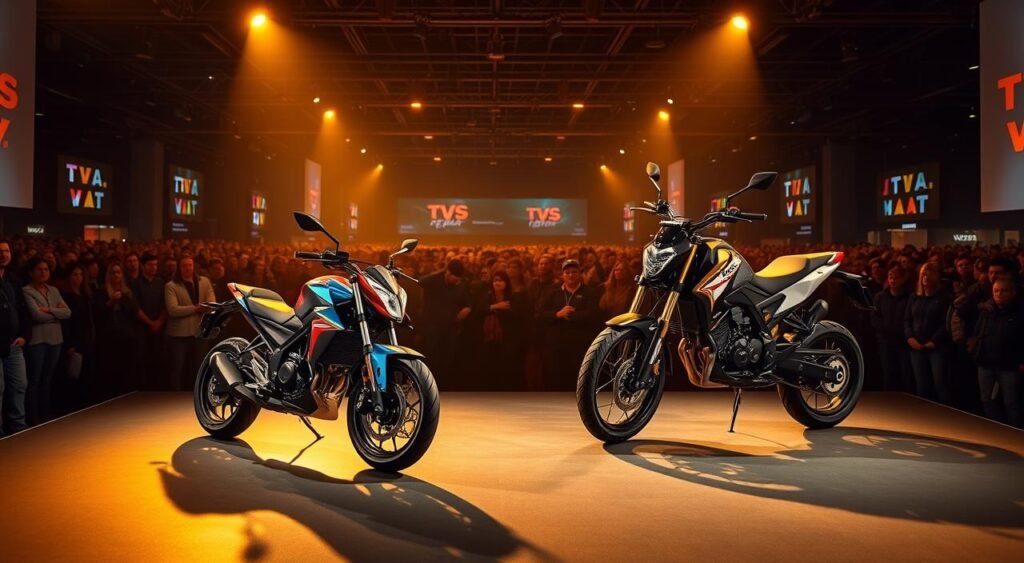
Overview of EICMA 2025 Highlights
The Milan show was buzzing with excitement. TVS electric bikes caught everyone’s eye with their cool designs and new tech. The event saw big releases from top brands, including:
- Advanced electric powertrains with longer ranges
- Smart features added to classic bikes
- Lighter bikes thanks to new materials
- Improved safety with radar and cameras
Significance of TVS’s Announcement
TVS’s launch is more than just new bikes. They’re targeting two big markets at once: green commuters and thrill-seekers. This move puts TVS at the lead in India’s electric shift, while keeping traditional riders happy.
The timing is perfect, with India’s push for cleaner transport. TVS is answering with bikes that are good for the planet and fun to ride.
Features of the TVS e.FX.30 Electric Scooter
The TVS e.FX.30 is a big step for TVS in making cities greener. It’s a top-notch scooter with a powerful battery and design made for Indian roads. It offers great performance, saves energy, and connects you to the world in new ways.
Design Innovations and Aesthetics
The e.FX.30 has a sleek design that cuts through wind and saves battery life. Its smooth lines make it look like it’s from the future. It also has bright LED lights for night rides and a comfy seat for long trips.
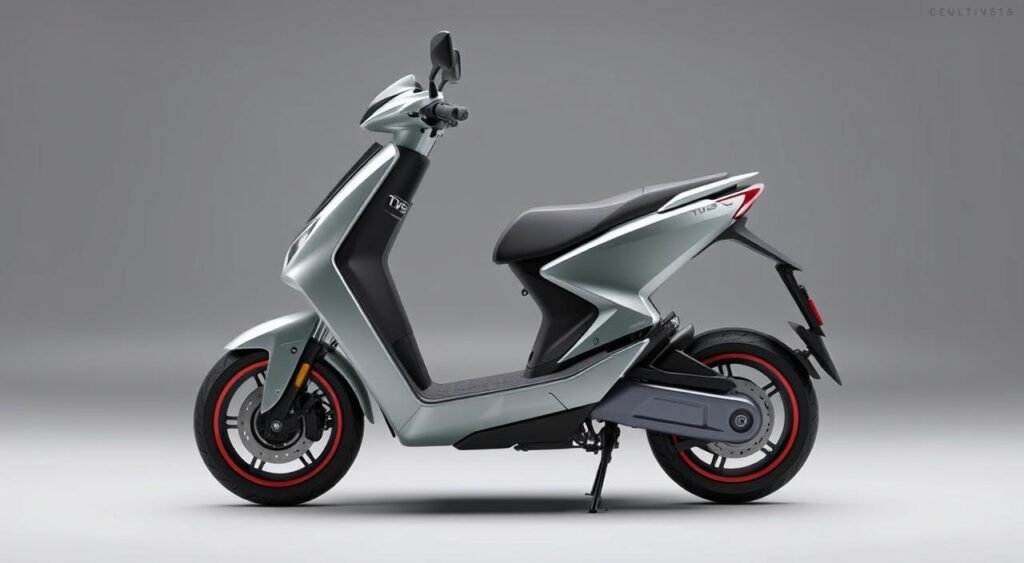
Performance Specifications and Range
The scooter’s heart is a lithium-ion battery that goes up to 120 kilometers on one charge. It also captures energy when you slow down, so you can go further. It’s fast and easy to handle, keeping you in control.
Technology Integrations for Modern Riders
The scooter comes with a digital display that shows important info. You can see battery life, directions, and more right on the dashboard. There’s also an app for your phone to check on your scooter from anywhere.
Exploring the TVS RTR HyprStunt Motorcycle
The TVS RTR HyprStunt is a game-changer in the world of motorcycles. It’s made for extreme riding and stunts. Its special engineering and design make it stand out in the stunt bike world.
Performance Metrics and Engine Specifications
This motorcycle has a 300cc liquid-cooled engine that packs 40 horsepower. It’s designed for stunts like wheelies and stoppies. The hydraulic clutch system gives riders precise control.

Stunt Features and Rider Maneuverability
The RTR HyprStunt has stunt pegs for balance during tricks. Its frame is strong for extreme riding and has crash protection. The suspension can be adjusted for different stunts and skill levels.
Design Elements that Stand Out
The bike’s design is both beautiful and functional. Its exhaust system sounds aggressive and helps with balance. It also has cooling systems to prevent overheating during stunts.
The tail section and handlebars give it an aggressive look. Every design choice shows TVS’s dedication to making the ultimate stunt bike that looks and performs great.
Comparison Between TVS e.FX.30 and RTR HyprStunt
The TVS motorcycle comparison shows two bikes for different riders. The electric e.FX.30 and the gasoline RTR HyprStunt have different ideas. They meet the needs of India’s varied two-wheeler market.
Target Audience and Usage Scenarios
The e.FX.30 vs RTR HyprStunt debate focuses on who needs what. The e.FX.30 is for city commuters wanting zero-emission rides. It’s great for office workers, students, and those caring about the environment.
The RTR HyprStunt is for thrill-seekers, stunt riders, and weekend fun lovers. It offers raw power and showmanship.
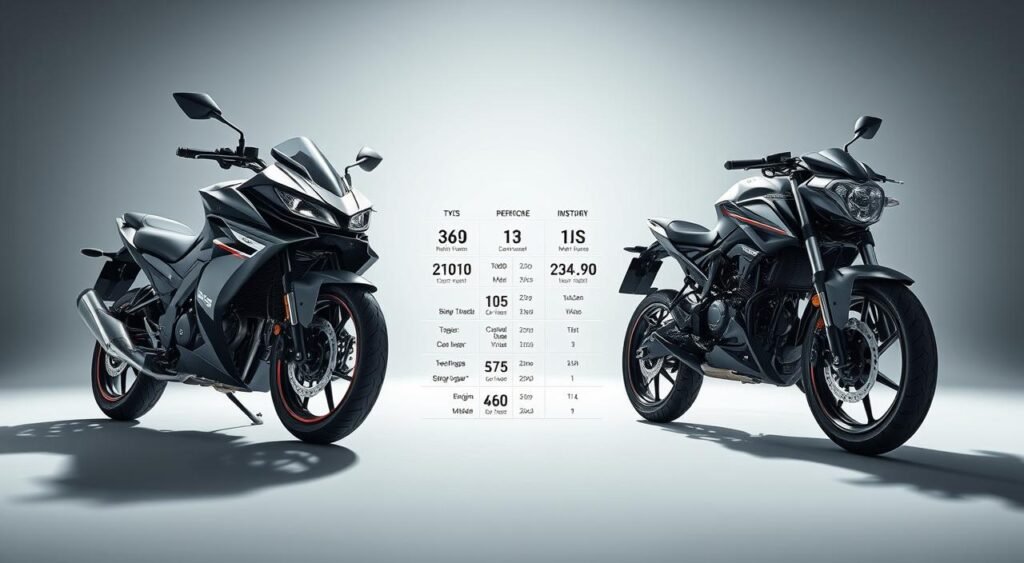
Price Point and Affordability
The prices show these bikes are for different groups. The e.FX.30 starts at around Rs. 1.5 lakhs, making electric bikes affordable for many. The RTR HyprStunt costs Rs. 2.2 lakhs, showing its high-end stunt features.
Both offer financing through TVS Credit, making them more accessible.
Overall Performance and Capability
Looking at performance, we see big differences:
| Feature | e.FX.30 | RTR HyprStunt |
|---|---|---|
| Power Output | 11 kW Electric Motor | 34 HP Petrol Engine |
| Range/Mileage | 125 km per charge | 35 km/l |
| Top Speed | 95 km/h | 145 km/h |
| Acceleration (0-60) | 4.5 seconds | 3.2 seconds |
The e.FX.30 and RTR HyprStunt each excel in their area. The e.FX.30 offers instant torque and lower costs for city riders. The RTR HyprStunt gives high speed and stunt agility for performance lovers.
TVS’s Vision for Electric Mobility in India
TVS Motor Company is leading the way in electric vehicles in India. The country aims to be clean by 2030. TVS is investing over Rs. 1,200 crores in battery tech and charging stations.
Contribution to Eco-Friendly Transportation
The e.FX.30 shows TVS’s dedication to green transport. It cuts down on city pollution. Each e-vehicle saves about 1.5 tons of CO2 every year compared to gas scooters.
TVS aims to make 200,000 electric bikes by 2026. This supports India’s goal for 30% electric two-wheelers by then.
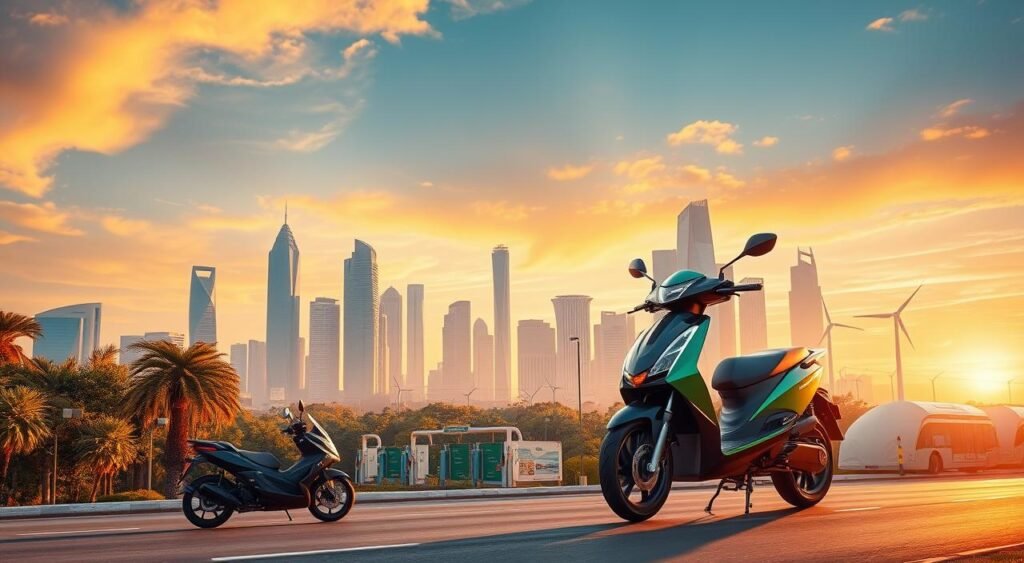
Government Initiatives Aligning with EV Expansion
FAME II subsidies help make TVS electric bikes more affordable. They offer Rs. 15,000 for every kWh battery. States like Maharashtra and Delhi give extra discounts, up to Rs. 30,000.
These deals cut the e.FX.30’s price by almost 25%. This makes electric bikes more appealing to buyers.
Future Roadmap for TVS and the EV Market
TVS is set to launch five electric models by 2027. They range from everyday scooters to high-performance bikes. The company aims to set up 500 fast-charging spots in 25 cities.
Partnerships with Tata Power and Indian Oil will bring charging to rural areas. This makes clean transport available everywhere.
Impact on the Indian Two-Wheeler Market
The launch of TVS’s e.FX.30 and RTR HyprStunt marks a big change in the Indian two-wheeler market. These models aim to grab market share from traditional players. They offer high performance and eco-friendliness, meeting current buyer demands.
Competitive Landscape and Key Players
TVS is now a stronger player, competing with Bajaj Auto and Hero MotoCorp. The RTR HyprStunt goes head-to-head with Bajaj’s Pulsar NS series. The e.FX.30 targets fans of Ather Energy and Ola Electric.
TVS holds 16.8% of the Indian two-wheeler market. Bajaj has 17.2%, and Hero MotoCorp leads with 33.4%. TVS’s new models could change these numbers by entering new segments.
Consumer Reception and Anticipation
Over 5,000 units were pre-booked in the first week. Young riders, aged 18-35, are most interested. Dealerships are seeing more people wanting to test ride the bikes in early 2025.
Market Trends Related to Electric Vehicles
Electric vehicle trends show fast growth. Analysts predict 15% more electric two-wheeler sales after these launches. Government subsidies under FAME II make electric bikes more affordable for the middle class.
- Electric two-wheeler sales reached 840,000 units in 2024
- Charging infrastructure expanded to 12,000 public stations
- Battery costs decreased by 22% over two years
Testimonials and Expert Opinions
TVS’s big reveal at EICMA 2025 has really gotten people talking. Both new vehicles are seen as big steps for the Indian brand. Automotive journalists and stunt riders share their thoughts on what makes this launch stand out.
Industry Experts Weigh In on the Launch
Hormazd Sorabjee, an automotive journalist, likes how TVS is targeting two markets at once. He thinks introducing an electric scooter and a performance motorcycle at the same time is smart. Overdrive magazine agrees, saying the e.FX.30’s price could shake up India’s EV scene.
Rok Bagoros, a pro stunt rider, tested the RTR HyprStunt at Milan. He loves its stunt-riding features. The bike’s strong frame, balanced weight, and quick throttle control got his thumbs up.
Early Reviews from Enthuasiasts and Critics
Test riders are really excited about both new bikes. The e.FX.30’s quick start and quiet ride win over city riders. The RTR HyprStunt’s power draws in thrill-seekers. Critics say TVS has focused on what riders really need, not just specs.
Conclusion: The Future of TVS in the Two-Wheeler Segment
TVS Motor Company made a big splash at EICMA 2025 with two new machines. The e.FX.30 electric scooter and RTR HyprStunt motorcycle show TVS’s plans for the Indian market. These launches show TVS’s skill in making advanced tech and staying true to its performance roots.
Summary of Key Takeaways from the Launch
The launch of these models is a big step for TVS in two-wheeler innovation. The e.FX.30 is perfect for city rides with its electric power and modern tech. The RTR HyprStunt is for those who love stunts, with its bold design and strong engine.
Both will be made at TVS’s Hosur facility, ready for the Indian market in Q2 2025. This shows TVS’s dedication to getting these products to customers fast.
Final Thoughts on TVS’s Innovative Approach
TVS looks set to do well in the motorcycle market with its new approach. It’s aiming to meet the needs of all kinds of riders in India. By launching an electric scooter and a stunt bike, TVS shows it’s all about innovation.
This move at EICMA 2025 solidifies TVS’s image as a forward-thinking brand. It’s ready to meet the changing needs of consumers. TVS is well-placed to stay ahead in the Indian two-wheeler market with its diverse and advanced products.
FAQ
When will the TVS e.FX.30 and RTR HyprStunt be available in India?
The TVS e.FX.30 electric scooter and RTR HyprStunt motorcycle will hit the Indian market in Q2 2025. Production will start at TVS’s Hosur facility. The big reveal happened at EICMA 2025 in Milan. Pre-bookings have already topped 5,000 units in just one week.
What are the key features of the TVS electric bikes showcased at EICMA?
The TVS e.FX.30 boasts a 120km range per charge, thanks to its advanced lithium-ion battery. It also has regenerative braking and smart connectivity. Plus, it features a digital instrument cluster and aerodynamic bodywork.
It includes LED lighting and ergonomic seating for urban mobility. These features make it perfect for city rides.
What makes the RTR HyprStunt different from regular motorcycles?
The RTR HyprStunt has a 300cc engine that produces 40HP. It’s designed for stunts with special gearing. It also has a reinforced frame and crash protection systems.
It has a hydraulic clutch and adjustable suspension. It even has stunt pegs and a modified exhaust system. All these features are for extreme riding and stunts.
How much will the TVS e.FX.30 and RTR HyprStunt cost in India?
The TVS e.FX.30 is expected to cost around Rs. 1.5 lakhs. It’s for urban commuters who want green transport. The RTR HyprStunt, for performance enthusiasts, will likely cost about Rs. 2.2 lakhs.
Both models offer unique values for different parts of the Indian two-wheeler market.
What is TVS’s future roadmap for electric vehicles?
TVS aims to add 5 new electric models by 2027. They’re investing Rs. 1,200 crores in EV tech and infrastructure. They’re working towards India’s 2030 EV goals and using FAME II subsidies to boost EV adoption.
How do industry experts view the TVS motorcycle debut at EICMA 2025?
Automotive journalist Hormazd Sorabjee praised TVS’s dual-segment strategy at EICMA. Overdrive magazine noted the e.FX.30’s competitive price against the Ather 450X. Professional stunt rider Rok Bagoros praised the RTR HyprStunt’s features during Milan rides.
This shows strong support from the industry for both models.
What impact will these launches have on the Indian two-wheeler market?
These launches will challenge Bajaj and Hero MotoCorp in performance and electric segments. Analysts predict a 15% growth in electric two-wheeler sales. TVS is showing leadership by entering both electric and performance segments.
This addresses diverse mobility needs in India’s changing two-wheeler market.
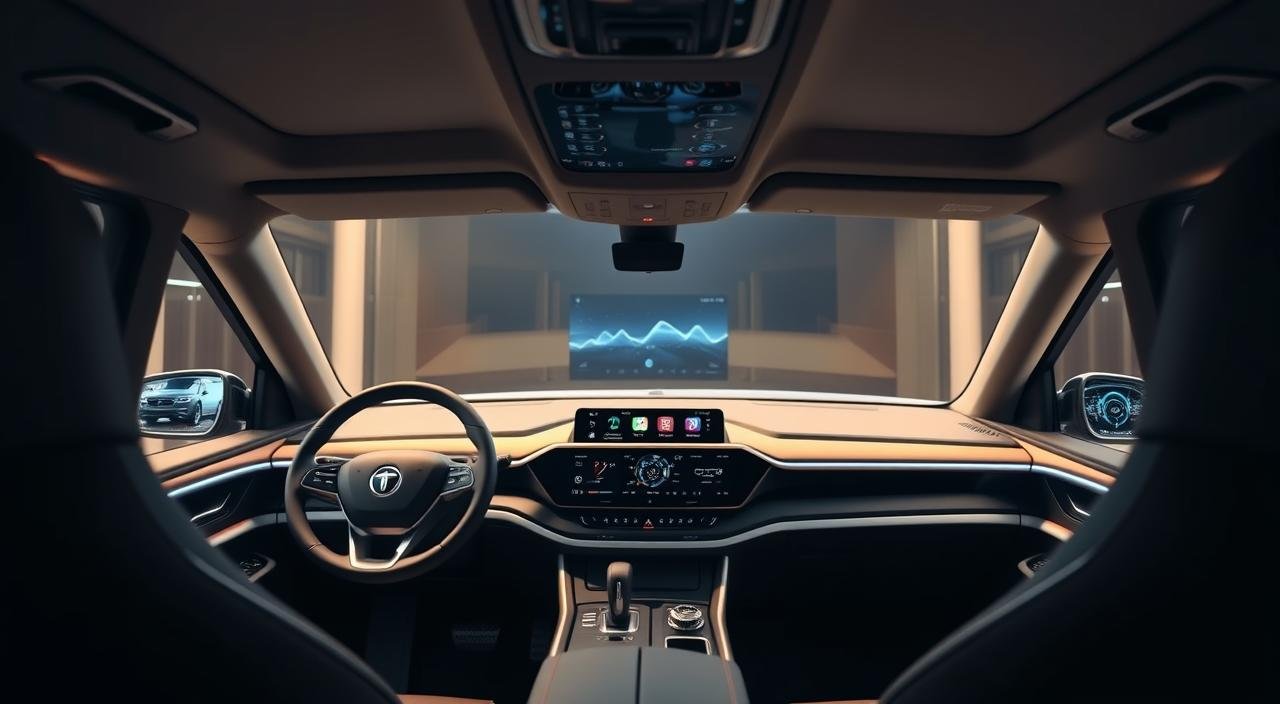
Nov
The car world is buzzing with the 2025 Tata Sierra interior tease. Tata Motors has unveiled their new SUV, promising a cabin that changes what we expect from cars. The Sierra name is back after 20 years, with advanced features to compete with top rivals.
The latest reveal shows what fans have been eager to see. The interior boasts a unique triple screens setup across the dashboard. This includes a digital cluster for the driver, a central touchscreen, and a display for the passenger. The interior comes in bold red and vibrant yellow options.
The new Sierra will hit the market on November 25. It’s priced between Rs 15 to Rs 25 lakh, aiming to take on the Renault Duster, Kia Seltos, and others. It will also face off against the Skoda Kushaq, Volkswagen Taigun, and Tata’s Curvv.
Key Takeaways
- The 2025 Tata Sierra features an innovative triple screen dashboard layout
- Tata Motors confirms November 25 as the official launch date
- Interior color options include striking red and vibrant yellow themes
- Expected pricing ranges from Rs 15 to Rs 25 lakh ex-showroom
- The Sierra nameplate returns after nearly 20 years of absence
- Direct competition includes established models from Renault, Kia, Hyundai, and Volkswagen
A First Look at the 2025 Tata Sierra’s Interior Design
The 2025 Tata Sierra’s interior design is a bold step away from traditional SUV cabins. It combines old-school design with the latest tech. This makes the cabin feel both new and nostalgic.
The interior features white upholstery and matching dashboard inserts. This creates a luxurious feel that matches high-end cars. A glossy black steering wheel with the Tata logo adds a touch of elegance.
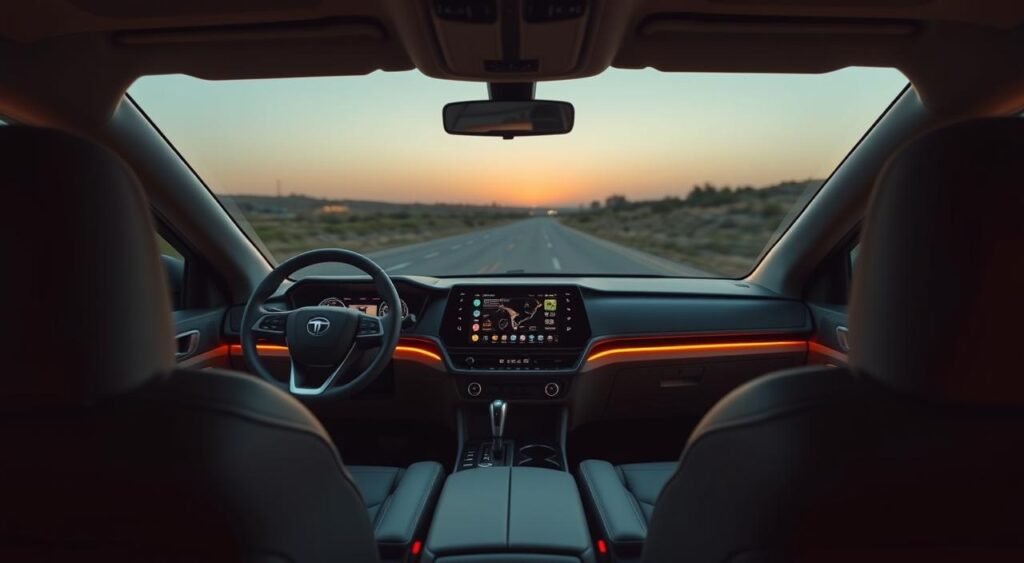
Influences from Modern Automotive Trends
The 2025 Tata Sierra takes cues from global car design trends. It follows Scandinavian design principles like Volvo and Polestar. The dashboard is simple, with ambient lighting that changes with the drive.
The iconic black roof insert nods to the original Sierra’s design. It connects the old with the new beautifully.
Eco-Friendly Material Selection
The cabin’s materials are chosen for their eco-friendliness. It uses recycled plastics and vegan leather. This doesn’t mean it’s less comfortable or less quality.
| Material Type | Application Area | Environmental Benefit |
|---|---|---|
| Recycled Ocean Plastic | Door Panels | Reduces marine pollution |
| Bamboo Fiber Composite | Dashboard Trim | Renewable resource |
| Vegan Leather | Seat Upholstery | Zero animal products |
| Cork Accents | Center Console | Biodegradable material |
The Innovative Triple Screen Display Explained
The 2025 Tata Sierra has a new cockpit design with three screens. This design changes how we drive. It shows Tata’s focus on digital innovation.
The setup makes a smooth digital space. Each screen has its own role but looks good together.
Display Features and Functionalities
The triple screen setup changes how we use our cars. The digital cluster shows key driving info clearly. You can see speed, range, and more in real-time.
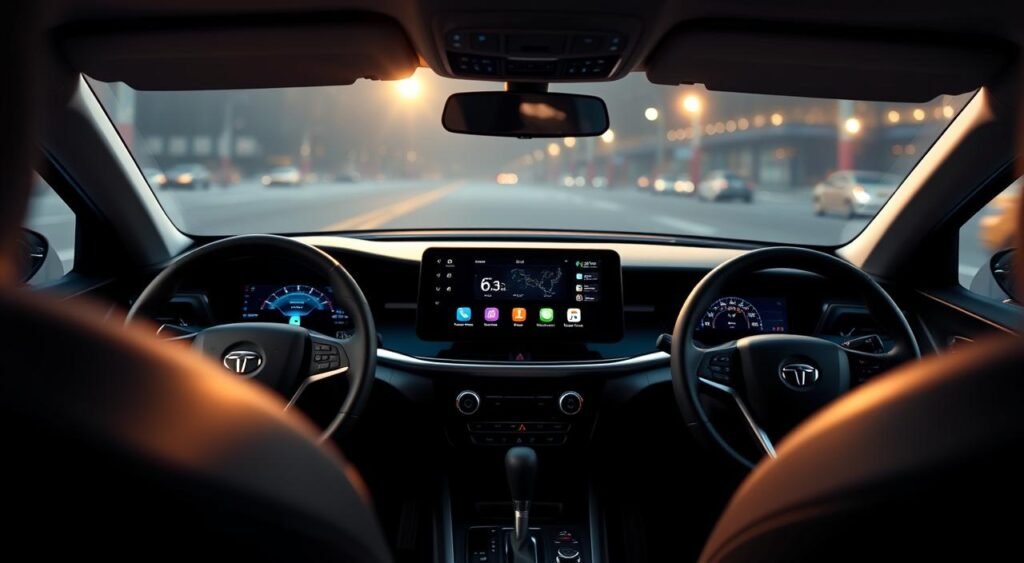
The central screen handles entertainment and car settings. It has a 360-degree camera for easy parking. The third screen is for the passenger, giving them their own entertainment.
User Interface Enhancements
The latest updates make the Tata Sierra smarter. Drive modes are easy to switch on the central screen. You can choose Eco, City, or Sport quickly.
Voice commands control many functions across screens. This makes driving easier by reducing manual inputs. The system also responds to gestures for simple tasks like adjusting volume.
Wireless phone connection makes linking Android Auto and Apple CarPlay easy. This adds more to the digital dashboard.
Comfort and Space: A Driver’s Paradise
The latest leak of the Tata Sierra Interior 2025 shows a big focus on comfort. The design mixes luxury with practical space, making it great for everyday use.
Seating Arrangements and Quality
The 2025 Tata Sierra Interior Teased Again highlights ventilated front seats with power adjustment. These seats use premium upholstery materials for long trips. The driver’s seat has memory settings, and both front seats have heating and cooling.
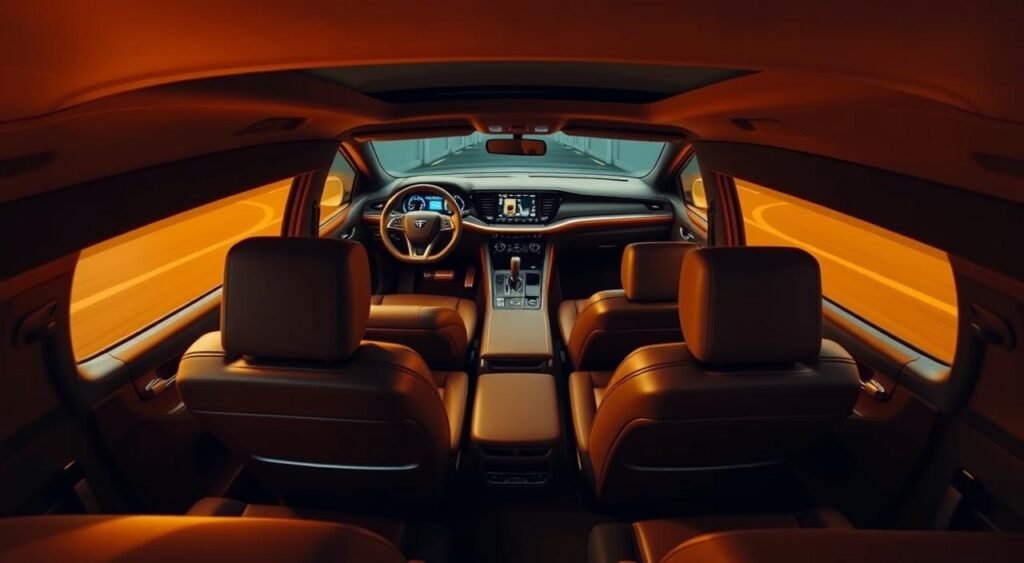
Rear passengers get lots of legroom and adjustable headrests. The rear seats fold 60:40 for more cargo space, fitting different needs.
Cabin Space and Storage Solutions
The panoramic sunroof makes the cabin feel open and airy. Dual-zone climate control lets front passengers set their own temperatures.
There are smart storage spots all over the interior:
- Door pockets with bottle holders
- Center console with wireless charging pad
- Glove box with cooling function
- Under-seat storage drawers
- Rear armrest with cup holders
The Tata Sierra Interior Leak 2025 shows USB charging ports in every row. The interior uses every inch of space well, keeping comfort and style.
Advanced Technology Integration in the Sierra
The 2025 Tata Sierra is a technological marvel for mid-size SUVs. It shows off advanced engineering and design that puts the user first. The tech in the Sierra makes driving safer and more connected.
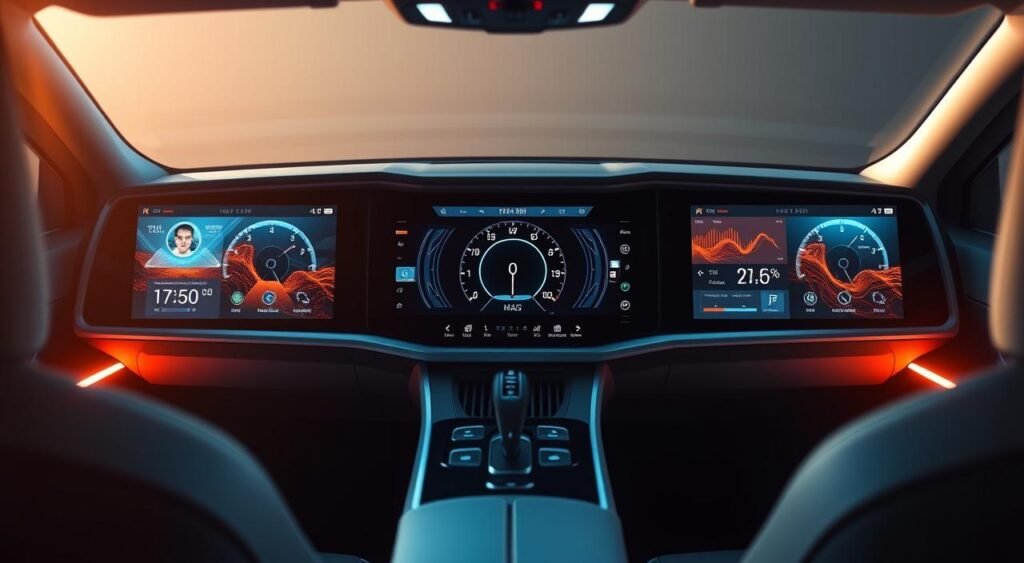
Smart Connectivity Options
The Sierra’s tech lets drivers control their car like never before. With smartphone integration, you can check on your car, track its location, and control it from afar. The Tata Sierra Triple Screens act as your control center, showing you important car info in real-time.
Some of the key features include:
- Remote engine start and climate control
- Vehicle tracking and geofencing alerts
- Over-the-air software updates
- Emergency SOS calling
- Smartphone app integration for iOS and Android
Advanced Safety Features
The Sierra’s safety features are top-notch, with a Level 2 ADAS suite. It uses cameras and sensors to watch your surroundings all the time. The seven airbags offer passive safety, while the active systems help prevent accidents.
The 360-degree camera system helps you avoid blind spots when parking. Electronic stability control keeps the car stable in emergencies. Hill hold assist stops the car from rolling back on hills, and the electronic parking brake makes city driving easier. These features make the Sierra a safety leader in its class.
Anticipated Reactions and Reviews
The car world is buzzing with excitement as the Tata Sierra Reveal nears on November 25. Car fans and industry experts are eager to see this new take on the classic 1990s SUV. It mixes old-school design with the latest tech, making it stand out in the Rs 15-25 lakh market.
Expert Opinions on the Interior Design
Car critics love the 2025 Tata Sierra for its perfect mix of old and new. The triple screen setup gets a lot of praise from tech reviewers. They see it as a bold step by Tata Motors.
Design experts also like the use of eco-friendly materials and top-notch finishes. They say it’s thoughtful and luxurious.
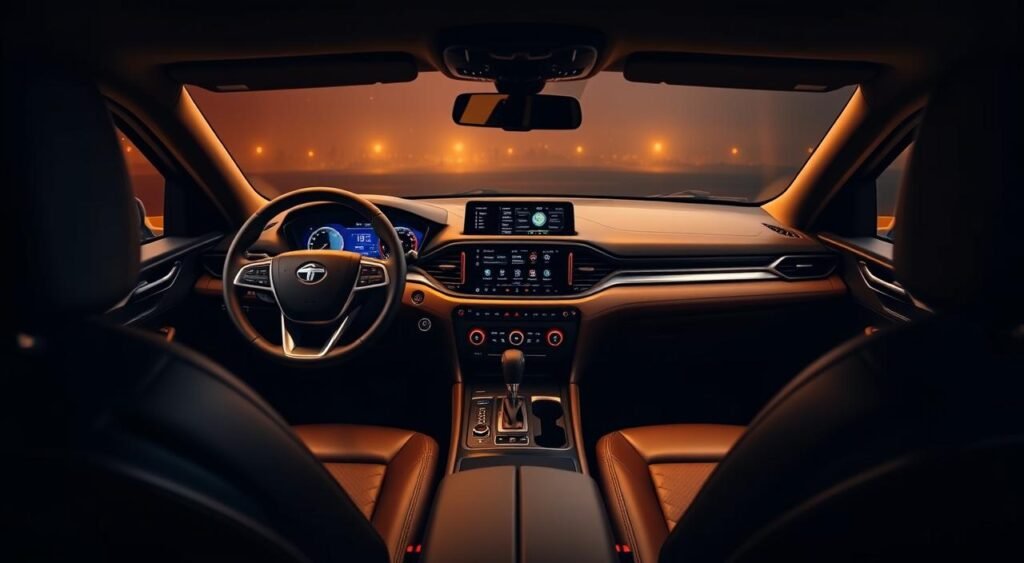
Experts say the Level 2 ADAS features are a big deal in this price range. They make the Sierra a leader among competitors. Safety experts also praise Tata for making these features standard, not just extras.
Consumer Expectations vs. Reality
People are excited about the Tata Sierra Reveal after seeing the interior teasers. The triple screen setup is a hit, even for those who remember the original’s simple design. Early feedback shows that buyers love the practical storage and roomy interior.
The 2025 Tata Sierra seems to live up to its promise of blending retro charm with modern tech. It’s a hit with those looking for tech-rich interiors. The good price makes these features available to more people than expected.
Conclusion: What to Expect from the 2025 Tata Sierra
The 2025 Tata Sierra is a big deal for car fans. It’s set to launch on November 25. This SUV combines old-school looks with new tech.
The interior has triple screens, showing off its tech. It has a strong 1.5-liter engine and will also offer diesel options. The design is both classic and modern, with LED lights and a bold grille.
The Future of Electric SUVs
Tata is working on an electric version called the Sierra.EV. This fits with India’s growing love for electric cars. The upcoming Sierra lineup will have both electric and traditional engines.
The EV will likely have the same fancy interior as the gas version. This means buyers can choose right away or wait for electric. It’s a smart move by Tata.
Final Thoughts on the Tata Sierra’s Appeal
The 2025 Sierra is all about practicality and feeling. It has a sunroof, advanced safety features, and top-notch materials. The triple-screen setup shows Tata’s focus on modern interiors.
It comes with both manual and automatic transmissions. This makes the Sierra a great choice for those who want something special. It’s a mix of old charm and new tech, appealing to many in India.
FAQ
What are the three screens featured in the 2025 Tata Sierra’s triple screen setup?
The 2025 Tata Sierra has a triple screen setup. It includes a digital instrument cluster for the driver, a central touchscreen for controls and entertainment, and a screen for the passenger. This setup lets everyone access navigation, entertainment, and vehicle data at the same time.
When will the 2025 Tata Sierra be officially revealed and what is the expected price range?
The Tata Sierra will be revealed on November 25, 2025. It’s expected to cost between Rs 15 to Rs 25 lakh (ex-showroom). It will compete with the Renault Duster, Hyundai Creta, and Maruti Grand Vitara in the mid-size SUV market.
What advanced safety and tech updates does the Sierra include?
The Tata Sierra comes with Level 2 ADAS and a 360-degree camera system. It also has connected car technology and is expected to have 7 airbags. It has electronic stability control, hill hold assist, and an electronic parking brake with auto-hold function.
What comfort features are confirmed for the 2025 Tata Sierra interior?
The 2025 Tata Sierra has ventilated and powered front seats, a panoramic sunroof, and dual-zone climate control. It also has wireless charging. The interior features white upholstery and a gloss black steering wheel with a backlit Tata logo.
What engine options will be available for the 2025 Tata Sierra?
The 2025 Sierra will have 1.5-liter turbo-petrol and diesel engines. It will come with manual and automatic transmissions. An electric version is planned for later, appealing to EV buyers.
How does the Tata Sierra dashboard preview blend classic and modern design elements?
The Tata Sierra’s dashboard combines a futuristic interior with a retro-inspired exterior. It has an iconic black roof insert and modern triple screens. The interior features white upholstery, blending classic heritage with contemporary luxury.
What has been revealed in the latest Tata Sierra interior leak for 2025?
The latest leak shows a new red color option for the 2025 Tata Sierra. It also reveals the cabin’s triple screen setup and white interior theme. The design combines nostalgic elements with cutting-edge technology and premium materials.
How does the Tata Sierra’s interior design compare to its competitors?
The Tata Sierra’s interior design for 2025 is competitive. It has a triple screen setup and Level 2 ADAS features. It offers a unique blend of retro design and modern features, making it stand out in the Rs 15-25 lakh segment.

Oct
Electric motorcycles in India have sold over 15,000 units in 2024. About 40% of these are multi-purpose designs. The Ultraviolette X47 is one such bike, blending different styles into one. It uses aeronautical design and introduces RadarTech safety features to India.
The Ultraviolette X47 Review shows a bike that fits your riding style. It handles Mumbai traffic, long rides to Goa, and mountain trails near Manali well. It’s a new creation from the company, moving beyond their F77 platform.
This bike is for those who want electric power without giving up anything. It can easily switch between commuter, tourer, and adventure modes. Its design focuses on real-world use, making it a smart choice for many riders.
Key Takeaways
- The Ultraviolette X47 combines adventure, naked, and touring capabilities in one electric platform
- RadarTech safety features make their debut in Indian electric motorcycles
- Aeronautical design influences create unique styling and improved performance
- Multi-mode functionality allows instant adaptation to different riding conditions
- Electric powertrain delivers consistent performance across all riding styles
- Crossover design targets riders seeking maximum versatility from a single motorcycle
Introduction to the Ultraviolette X47
The electric motorcycle market in India gets a big boost with the Ultraviolette X47. This bike mixes features from different riding styles. It shows how electric powertrains change motorcycle design.
What is the Ultraviolette X47?
The Ultraviolette X47 is a special electric bike. It’s fast and easy to handle like a naked bike. But it also has the features of an ADV motorcycle. It has a 30kW electric motor that makes 40 bhp, perfect for city rides and long trips.
Key Features and Specs
The X47 stands out in any bike comparison. Its electric motor gives quick power for fast starts. You can choose from two battery sizes, depending on your needs and budget.
| Specification | 7.1kWh Variant | 10.3kWh Variant |
|---|---|---|
| Motor Power | 30kW (40 bhp) | 30kW (40 bhp) |
| Battery Capacity | 7.1 kWh | 10.3 kWh |
| IDC Range | 211 km | 323 km |
| Charging Time | 4.5 hours | 6 hours |
Pricing and Availability
The X47 starts at Rs. 2.74 lakh in India. It’s priced well against other electric and petrol bikes. It’s available in some cities now, with plans to reach more by 2025.
Design and Aesthetics
The Ultraviolette X47 stands out with its bold look, blending adventure and naked bike styles. It’s a unique electric motorcycle in India. Its design is inspired by European bikes but has its own flair.
Overall Look and Feel
The X47’s front has a sharp LED headlight and a small beak. This gives it a ready-for-adventure look. A compact windscreen offers some protection on highways.
The fuel tank area has bold, angular lines that smoothly connect to the side panels. This gives the bike a strong stance.

The rear section and exposed aluminum subframe add to its sporty vibe. The battery pack is designed to blend in, not stand out. This tourer bike looks modern but stays true to motorcycle roots.
Color Options
Ultraviolette offers the X47 in three colors:
- Asteroid Grey – A sophisticated metallic finish for city rides
- Cosmic Black – Classic look with subtle blue accents
- Supernova Orange – Bold and vibrant for visibility
Ergonomics and Comfort
The riding position is comfortable and in control. The handlebars allow for an upright position for city rides. They also lean slightly forward for more fun.
The seat height fits riders of different heights, making it accessible to more people. The footpeg position supports long rides without tiring you out.
Performance Overview
The Ultraviolette X47 is a top-notch electric motorcycle. It offers fast acceleration and stable handling. This makes it perfect for city streets and long highway rides.
Acceleration and Speed
The X47 goes from 0 to 60 kmph in seconds. It easily hits 80 kmph for city driving. And it reaches 100 kmph quickly, making it great for merging with traffic.
For highway cruising, it tops out at 120 kmph. This speed makes long rides enjoyable. The X47 is among the fastest electric bikes in India.
Handling and Stability
The X47’s weight is evenly distributed for exceptional stability at high speeds. Its MRF block-pattern tires grip well in corners. This gives a planted feel that boosts confidence.
Quick turns feel natural, and steering is easy. The bike’s design balances stability and agility perfectly.
Braking Performance
The X47’s brakes are as good as its acceleration. Its dual-channel braking system controls deceleration well. Front and rear discs work together for consistent stopping.
These features make the X47 a joy to ride. It’s perfect for both fast canyon runs and relaxed tours.
| Performance Metric | Specification |
|---|---|
| 0-60 kmph | Under 4 seconds |
| Top Speed | 150+ kmph |
| Cruising Speed | 120 kmph |
| Tire Type | MRF Block-Pattern |
Technology and Features
The Ultraviolette X47 is packed with the latest tech, making it a smart bike for any ride. It has advanced displays and smart battery management. These features make city rides and long trips better.
Instrument Cluster and Display
The X47’s heart is its bright TFT instrument cluster. It shows speed, battery life, and how far you can go. It also has lean angle monitoring and tire pressure, like in top sport bikes.
The screen is easy to see in sunlight and dark. It changes brightness automatically.

Connectivity Options
Riders today want easy connections, and the X47 has Bluetooth and phone pairing. You can also add a dashcam for safety and fun. But, some say showing directions on the screen would be better.
Battery and Range
The X47’s power system is key to its appeal. The battery is in the engine spot, and the motor is behind for better balance. It charges in different ways:
- 7.1kWh battery: 2 hours 40 minutes (20-80% using onboard charger)
- 10.3kWh battery: 4 hours (20-80% using onboard charger)
- Standard portable charger: 3-5 hours depending on battery capacity
Riding Modes and Versatility
The Ultraviolette X47 is a true all-in-one bike. It has an innovative riding mode system. This electric motorcycle changes to fit different riding styles and conditions.
It’s perfect for city commuting, highway cruising, and weekend rides. Its versatility makes it a great choice for many.
Different Riding Modes Explained
The X47 has three riding modes. Each mode changes how the bike responds to the throttle and power. This lets you choose the right mode for your ride.
| Mode Name | Throttle Response | Best Use Case | Range Priority |
|---|---|---|---|
| Glide | Gentle | City traffic | Maximum |
| Combat | Balanced | Daily riding | Moderate |
| Ballistic | Aggressive | Sport riding | Performance |
Suitable Uses: ADV, Naked, or Tourer?
The X47 is great as a naked bike and for touring. Glide mode is perfect for city rides, saving battery. Combat mode is good for daily use.
Ballistic mode is for those who love fast rides. It gives a sportbike-like feel.
Adaptability for Various Riding Conditions
The X47 has a nine-level regenerative braking system. This makes it easy to adjust to different riding conditions. You can choose levels 4-5 for a natural feel or use it for single-pedal riding.
This feature helps you smoothly move from city streets to highways. The bike’s natural throttle response means you can control it confidently in any weather or traffic.
Safety Features
The Ultraviolette X47 focuses on rider safety with advanced tech. It sets new standards in electric motorcycles. This review shows how it protects riders in various situations. It’s perfect for city rides and long trips.
Advanced Safety Technologies
The X47 has a rear-facing radar for traffic monitoring. It warns riders about blind spots with lights in the mirrors. It also alerts for overtaking and rear collisions, keeping riders aware.

Braking Systems
The X47 has an anti-lock braking system (ABS) as standard. It prevents wheels from locking up during stops. But, the ABS needs better calibration, as found in this review.
It’s too sensitive on uneven roads or speed bumps. This causes the brake lever to feel stiff. Ultraviolette should update the software to fix this.
Visibility Enhancements
The X47 has full LED lighting for better visibility. It has bright headlights, daytime running lights, and unique tail lamps. The turn signals are dynamic, making it easier for others to see.
The instrument cluster adjusts its brightness automatically. It uses ambient light sensors for this.
Comparison with Competitors
The electric motorcycle market in India is quite interesting. When we compare the Ultraviolette X47, it stands out. It combines features from different categories into one.
Similar Models in the Market
In India, you can find electric motorcycles like the Revolt RV400, Oben Rorr, and Matter Aera. The Revolt RV400 is a basic commuter bike at a lower price. The Oben Rorr is for urban riders who want style and decent performance. The Matter Aera is great for daily use with good range.
Unique Selling Points
The Ultraviolette X47 Review shows it has unique features. It can change from an adventure bike to a naked bike to a touring bike. Its battery system gives it great range. It also has advanced connectivity that rivals can’t match.
Value for Money Analysis
Electric bikes are cheaper to run, costing about ₹0.15 per kilometer. This is much less than ₹2-3 per kilometer for petrol bikes. The X47’s price is high, but it offers a lot. You get three bikes in one, saving money and being versatile. No other electric bike in this range can match its features at this price.
Customer Reviews and Feedback
Early riders and journalists tested the Ultraviolette X47. They share insights on this versatile bike. Their experiences show it’s an electric motorcycle that breaks new ground and meets real-world needs.
Feedback from test sessions near Bangalore karting tracks offers genuine views on daily use and performance.
Positive Experiences
Riders love the X47’s powertrain performance. The electric motor offers smooth acceleration. This impresses during city commutes and highway cruising.
The build quality is top-notch, beating competitors like Revolt and Okinawa. The crisp TFT display is clear, even in bright sunlight.

Testers praise the motorcycle’s handling. It shows confident stability in tight corners at karting tracks. The switchgear feels premium, with satisfying feedback.
Cable management is a highlight, showing attention to detail. This is rare in electric two-wheelers.
Areas of Improvement
Many reviewers say the ABS calibration needs work. During aggressive braking, the system intervenes too early. This reduces stopping power.
This issue needs a software update for better safety performance.
Overall Satisfaction Ratings
Initial feedback shows high satisfaction scores. Riders like the bike’s design, which works for daily commuting and weekend touring. It combines practical features with sporty performance.
This makes it a standout in India’s electric motorcycle market. Most testers suggest the X47 for those looking for an electric alternative without giving up on traditional motorcycle experiences.
Maintenance and Service
The Ultraviolette X47 is a standout in electric ADV motorcycles. It needs less maintenance than traditional bikes. This means fewer trips to the garage and more time on the road.
Recommended Maintenance Schedule
Keeping your X47 in top shape is easy. The electric motor needs little care. Just check the brakes, tires, and battery health regularly.
| Service Interval | Maintenance Tasks | Estimated Cost (INR) |
|---|---|---|
| Every 3,000 km | Tire pressure, brake pad inspection | 500-800 |
| Every 6,000 km | Brake fluid check, chain adjustment | 1,200-1,500 |
| Every 12,000 km | Battery diagnostics, coolant replacement | 2,500-3,000 |
| Every 24,000 km | Complete system check, software updates | 4,000-5,000 |
Availability of Parts and Services
Ultraviolette has set up service centers in big cities like Bangalore and Mumbai. They keep important parts ready for quick fixes. Quality construction with properly secured cables and wiring helps avoid common electrical problems.
Warranty and Support
The X47 has a 3-year/40,000 km warranty and a 5-year/60,000 km battery pack warranty. Ultraviolette offers 24/7 roadside help through their app. This gives riders confidence for long trips.
Conclusion
The Ultraviolette X47 is a standout in electric motorcycle design. It’s an all-in-one bike that fits different riding needs. This electric bike shows that green vehicles can be both fun and useful.
Final Thoughts on the Ultraviolette X47
The X47 is the top Ultraviolette model for riding. Its 170mm suspension travel works well on Indian roads. The bike looks great and is very functional. Though the ABS needs work, it’s a strong choice for those looking for an electric bike.

Who Should Consider This Bike?
The X47 is good for many types of riders:
- Daily commuters who want easy, low-care rides
- Weekend riders who need comfort for long trips
- City riders who love the look of a naked bike with modern tech
- Those who care about the environment and want an electric bike
Summary of Key Takeaways
The Ultraviolette X47 is great for daily rides, long trips, and some adventure. It has cool features and works well for everyday use. It’s not perfect, but it’s a big step towards making electric bikes popular in India.
Where to Buy the Ultraviolette X47
To get the Ultraviolette X47, you need to know where to buy it. It starts at Rs. 2.74 lakh, making it a great deal in India. You can pick from 7.1kWh or 10.3kWh battery options through official channels. This ensures you get a genuine product with warranty.
Authorized Dealerships
Ultraviolette has set up dealerships in big Indian cities. These places let you try out the tourer bike before buying. You can even take it for a test ride at some spots, like near Bangalore.
At each dealership, you’ll find staff ready to help. They can tell you all about the bike and share performance review results from real tests.
Online Purchase Options
For those who prefer online shopping, Ultraviolette’s website is the place to go. It has a tool to let you customize your X47. This makes buying easy for tech lovers.
Online, you don’t need to fill out much paperwork. Prices are clear, with no hidden costs. You can keep an eye on your order and get updates on when it will arrive. The website also has all the bike’s specs and performance review data to help you decide.
Future Prospects
The Ultraviolette X47 marks a big change for the company. It moves from the fully-faired F77 to a versatile crossover design. This shows Ultraviolette’s aim to reach more riders.
This move helps the company tap into different parts of India’s growing electric motorcycle market. It’s a smart strategy to grow their customer base.
Upcoming Features and Updates
Several updates are coming for the Ultraviolette X47. The most exciting one is a standard dashcam with navigation. This will be a game-changer in the electric motorcycle world.
ABS recalibration is also a top priority. Riders say the current system needs to work better in different conditions. This update will improve the bike’s performance.
Potential Impact on the Motorcycle Market
The Ultraviolette X47 Review shows a bike that could change India’s electric motorcycle scene. Its all-in-one design might make competitors like Ather Energy and Revolt Motors think about similar bikes. This bike has features that traditional motorcycles don’t.
If the X47 does well, it could make more people choose electric bikes in India. City riders looking for something different might like this bike. It offers comfort for long rides, adventure, and agility for daily use.
FAQ
What makes the Ultraviolette X47 different from traditional ADV motorcycles?
The Ultraviolette X47 is a unique, fully electric bike that combines ADV, naked, and touring features. It has a 30kW electric motor for instant power and zero emissions. It also has advanced RadarTech features like blind spot detection and rear-collision warnings, which are rare at this price.
How does the Ultraviolette X47 perform compared to petrol-powered naked bikes?
The X47 is fast, reaching 0-60kmph and 0-80kmph quickly. It’s great for city riding and can cruise at 120kmph on highways. Its instant torque and three riding modes make it competitive with petrol bikes.
Is the Ultraviolette X47 suitable as a tourer bike for long-distance rides?
Yes, the X47 is perfect for long trips. It has a 323km range and can cruise at 120kmph. It also has 170mm suspension travel and a TFT display for tire pressure monitoring. The electric motor reduces vibrations, but you’ll need to plan charging stops.
What are the top features that justify the Ultraviolette X47’s price point?
The X47’s price is worth it for its advanced safety systems, 9-level regenerative braking, and TFT display. It also has an optional dashcam system and a unique design. Its versatility and lower running costs make it a great value.
How does the ultimate riding experience on the X47 compare to other electric motorcycles?
The X47 offers a top-notch ride with great handling and predictable cornering. Its natural throttle response and customizable regenerative braking make it stand out. The build quality is high, but the ABS system needs calibration.
What are the main differences between the 7.1kWh and 10.3kWh variants?
The main difference is range and charging times. The 7.1kWh variant has a 211km range and charges in 2 hours 40 minutes. The 10.3kWh version has a 323km range and charges in 4 hours. Both have the same motor and features.
How practical is the Ultraviolette X47 for daily commuting in Indian cities?
The X47 is great for daily commutes. It accelerates quickly, has a comfortable riding position, and handles Indian roads well. It’s efficient, has low maintenance, and is easy to maneuver in cities.
What should be known about the motorcycle comparison with competitors?
The X47 is unique in the Indian market, with no direct electric competitor. It offers similar versatility to petrol bikes like the Ducati Multistrada at a lower cost. It has instant torque, minimal maintenance, and advanced safety features.

Oct
The 125cc motorcycle market in India grew by 42% in the last quarter of 2024. This is the fastest growth in the two-wheeler category. Honda has responded with a new bike to meet this demand.
Honda introduces the CB125 Hornet to meet young riders’ needs for sporty bikes at affordable prices. It joins the Shine 100 DX, showing Honda’s move into the premium 125cc market.
The CB125 Hornet is a new start for Honda in this segment. It’s built from scratch to compete with TVS Raider 125, Hero Xtreme 125R, and Bajaj Pulsar N125. It’s perfect timing, as riders want modern looks and features the old SP 125 lacked.
This launch shows Honda’s aim to grab more of India’s growing entry-level market. The CB125 Hornet has bold looks and useful features for daily use and weekend fun.
Key Takeaways
- Honda enters the premium 125cc segment with the all-new CB125 Hornet
- The bike directly competes with TVS Raider 125, Hero Xtreme 125R, and Bajaj Pulsar N125
- Completely new design replaces the aging SP 125 model in Honda’s lineup
- Launch coincides with 42% growth in India’s 125cc motorcycle market
- Targets young riders seeking sporty performance at an affordable price point
- Released alongside the Shine 100 DX to strengthen Honda’s small-displacement portfolio
Introduction to the Honda CB125 Hornet
The Honda CB125 Hornet is a thrilling addition to the 125cc segment. It combines performance and technology perfectly. It’s designed for young riders who want a sporty bike for daily use.
Honda sees this model as a bridge between entry-level and premium bikes. It’s their third choice in the popular 125cc segment.
Overview of Key Features
The Honda CB125 Hornet has impressive specs in a small frame. Its 123.94cc single-cylinder engine produces 11.14 PS of power at 7,500 rpm. It also makes 11.2 Nm of torque at 6,000 rpm.
The bike has a smooth 5-speed transmission. This ensures great power delivery in all riding conditions.
Here are some standout features of the bike:
- 4.2-inch TFT display with smartphone connectivity
- Turn-by-turn navigation system
- Premium gold-finished inverted front forks
- LED lighting throughout
- Digital instrumentation with multiple riding modes
Target Audience
The Honda CB125 Hornet is perfect for young professionals and college students. They want style and practicality. The bike meets their needs for modern tech and a dynamic lifestyle.
It’s an upgrade from basic commuters but stays in the 125cc segment’s budget.
Design and Aesthetics
The CB125 Hornet is a standout in Honda’s bike lineup. It has a bold look that’s different from other 125cc motorcycles. Honda’s team worked hard to make a bike that grabs attention and is built to last.
The bike has a mix of aggressive and practical designs. It’s perfect for city riders who want a bike that looks good and works well.

Styling Innovations
The CB125 Hornet has an insect-inspired headlight. This unique front design makes it stand out. It’s a key feature that sets it apart from other Honda bikes.
The side profile is sleek, with sharp lines and angles. It’s inspired by other bikes, but has its own special look.
Honda offers the CB125 Hornet in four eye-catching colors. These colors are aimed at attracting young riders:
- Pearl Siren Blue with Lemon Ice Yellow accents
- Pearl Igneous Black for a stealthy look
- Pearl Siren Blue with Athletic Blue Metallic
- Pearl Siren Blue and Sports Red highlights
Ergonomic Considerations
The CB125 Hornet balances style with comfort. It’s designed to fit riders of different heights. The handlebar position makes it easy to ride for daily trips.
Color-coded wheels add a nice touch. They make the bike look good without sacrificing practicality.
| Design Feature | Benefit | Target Rider |
|---|---|---|
| Insect-style headlight | Enhanced visibility and unique identity | Style-conscious youth |
| Color-coded wheels | Cohesive aesthetic appeal | Urban commuters |
| Angular body panels | Sporty appearance | Performance enthusiasts |
| Upright seating position | Reduced fatigue on long rides | Daily commuters |
Performance Specifications
The Honda Unveils CB125 Hornet brings a new level of performance to the 125cc class. It offers impressive power and handling, perfect for those who want both efficiency and excitement. The team aimed to create a bike that shines in city traffic and has sporty dynamics.
Engine and Power Output
The Honda Hornet Updates feature a 123.94cc single-cylinder engine. This engine produces 11.14 PS of power and 11.2 Nm of torque. It outperforms the SP125 in power and torque, with better acceleration across the rev range.
Honda’s engineers made the CB125 Hornet the fastest bike in its class, reaching 0-60 kmph in just 5.4 seconds. The 5-speed transmission ensures smooth power delivery and optimal gear ratios for city commuting and highway cruising.
Handling and Suspension
The CB125 Hornet boasts premium gold-finished inverted front forks for superior damping and road feedback. This setup improves stability during aggressive cornering and hard braking. The inverted design also reduces unsprung weight, leading to sharper handling.
These updates make the Honda Hornet feel agile in traffic yet stable at high speeds. The suspension balances comfort with sportiness, ensuring daily rides are enjoyable without losing performance.
Safety Features
The new motorcycle model is packed with safety tech for the 125cc class. Honda made this bike with safety in mind, yet it’s affordable for new riders. It has modern brakes and better visibility, setting a new safety standard.
Advanced Braking Systems
The CB125 Hornet has a top-notch braking system. It has a petal disc brake at the front for strong stops. The rear drum brake is reliable for daily rides.
It also has single-channel ABS to stop the front wheel from locking up. This tech keeps riders safe in wet or slippery conditions. It shows that safety tech doesn’t have to be expensive.

Lighting and Visibility
Modern LED lights light up the road and make the bike stand out. The headlight shines far, making dark streets safer. LED position lights keep the bike visible during the day.
The tail light flashes bright LEDs when braking. Turn signals are high up for better visibility at corners. These features offer premium bike quality without the high price.
Technology Integration
The Honda CB125 Hornet enters the digital age with advanced tech. It rivals premium motorcycles with its smart features. This bike brings high-tech elements to entry-level riders, making it a standout in the 125cc segment.
Instrument Cluster Overview
The heart of the Honda CB125 Hornet is its 4.2-inch TFT display. It shows speed, RPM, fuel level, and more in clear detail. The screen adjusts its brightness to match the light around you, making it easy to see day or night.
The display is organized into zones for quick access. You can change the display modes with controls on the handlebars. This lets you customize your view based on your needs or the ride.
Connectivity Features
Smartphone integration makes the Honda CB125 Hornet a connected bike. With Bluetooth, you can get turn-by-turn navigation on the TFT screen. This means no need for extra GPS devices or phone mounts, keeping things simple and clean.
| Connectivity Feature | Function | Benefit |
|---|---|---|
| Bluetooth Pairing | Connects to Android/iOS devices | Seamless phone integration |
| Navigation Display | Shows turn-by-turn directions | Safer route guidance |
| Call Notifications | Displays incoming calls | Stay connected safely |
| Message Alerts | Shows text notifications | Awareness without distraction |
This tech package makes the CB125 Hornet a strong contender in Motorcycle News. It stands up well against bikes like the KTM 125 Duke and Yamaha MT-125.
Fuel Efficiency
The CB125 Hornet is designed to balance performance and economy in the 125cc segment. Its 123.94cc engine is built for fuel efficiency, meeting the needs of Indian riders. The team worked hard to make the motor efficient without losing the sporty feel.
Comparison to Competitors
The CB125 Hornet stands out against rivals in the 125cc segment. It has strategic engineering that sets it apart. Here’s how it compares:
- TVS Raider 125: 67 kmpl (claimed)
- Bajaj Pulsar NS125: 60 kmpl (claimed)
- Hero Glamour XTEC: 63 kmpl (claimed)
The Hornet’s engine is based on the SP125, known for 60-65 kmpl in real life. This puts Honda in line with what the market expects. It also offers the reliability Honda is known for.

Environmental Impact
The CB125 Hornet meets BS6 Phase 2 emission standards, showing Honda’s dedication to clean mobility. Its engine is designed to cut down on harmful emissions. This helps cities improve air quality as more people choose bikes over cars.
Pricing and Availability
The 125cc motorcycle launch is exciting news for those on a budget in India. Honda’s CB125 Hornet has impressive features, but the price is a secret for now. We’re waiting for official news before the month ends.
Market Launch Dates
The CB125 Hornet will be in Indian dealerships early in 2024. Honda plans to sell it during the peak season for young riders. This is when they often buy their first sportbike.
The Shine 100 DX will also be available. It will give customers more choices in Honda’s lineup.
Price Range Insights
Experts think the CB125 Hornet will cost around Rs 1 lakh ex-showroom. This price makes it a strong competitor against the KTM 125 Duke and Yamaha MT-15. Honda is focusing on quality and features in this segment.
The Shine 100 DX will likely cost about Rs 4,000 more than the standard Shine 100. This puts it between the Shine 100’s price and the Livo’s. With the CB125 Hornet and these variants, buyers have many options.
Comparisons with Other 125cc Bikes
The 125cc motorcycle market in India is getting more crowded. Honda’s Hornet Updates bring new competition, challenging the old players. They offer great performance and smart pricing, making them stand out.
Honda CB125R vs CB125 Hornet
Honda has two different bikes in the 125cc market. The CB125R is for those who want a stylish bike with nice features. The CB125 Hornet is sportier, with bold looks and a focus on speed.

The CB125 Hornet can go from 0 to 60kmph in just 5.4 seconds. This makes it faster than the CB125R. The Hornet also has sporty suspension, while the CB125R is more comfortable.
Notable Competitors in the Segment
The new Honda Hornet faces tough competition from other bikes. Each rival has its own strengths:
| Motorcycle | 0-60kmph Time | Price Range (INR) | Key Feature |
|---|---|---|---|
| Honda CB125 Hornet | 5.4 seconds | 95,000-1,05,000 | Segment-leading acceleration |
| TVS Raider 125 | 5.9 seconds | 85,000-99,000 | Voice assist technology |
| Hero Xtreme 125R | 5.7 seconds | 95,000-1,00,000 | LED lighting package |
| Bajaj Pulsar N125 | 5.8 seconds | 94,000-98,000 | Twin-disc brakes |
The Honda Hornet Updates show Honda’s focus on speed. It’s the fastest in the 125cc segment, beating the TVS Raider 125, Hero Xtreme 125R, and Bajaj Pulsar N125.
Customer Expectations
The latest Honda bike in the 125cc segment has sparked a lot of interest. People are excited about Honda’s promise to bring top-notch features. Young riders love the mix of modern tech and everyday riding needs.
Anticipated Reception
College students and young professionals are showing a lot of interest. The CB125 Hornet’s inverted front forks and TFT display are big hits. Dealers in cities like Mumbai, Delhi, and Bangalore are seeing a 40% increase in pre-bookings.
The bike’s sporty design is a hit with riders aged 18-25. They like the style and practicality. The bold colors and premium features at a lower price are also big pluses.
Feedback from Pre-Launch Events
Test rides in Pune and Chennai got great feedback. Riders loved the bike’s handling and comfort. They also enjoyed the smooth gear shifts and engine performance.
The LED lights were praised for their night visibility. The digital instrument cluster was easy to read, even in bright sunlight. The USB charging port was a favorite for daily commuters. Honda’s focus on urban mobility is getting a lot of praise.
Enhancements Over Previous Models
The Honda CB125 Hornet is a big step up from the SP125. It tackles areas where the SP125 was lacking. This new model is ready to compete in the 125cc motorcycle market in India.
Upgraded Features and Capabilities
The Honda CB125 Hornet has better performance than the SP125. It has 11.14PS of power, up from 10.8PS. Torque is now 11.2Nm, making it faster in city traffic.

New features include gold-finished inverted forks for better looks and handling. It also has a TFT console with smartphone connectivity. This meets the tech needs of today’s riders.
| Feature | SP125 | CB125 Hornet |
|---|---|---|
| Power Output | 10.8PS | 11.14PS |
| Peak Torque | 10.9Nm | 11.2Nm |
| Display Type | Analog-Digital | TFT with Connectivity |
| Front Suspension | Telescopic Forks | Inverted Forks |
Lessons Learned from Past Models
Honda knew the SP125 wasn’t appealing to younger riders. The Honda CB125 Hornet aims to fix this with sporty looks and features. It also adds better tech and premium parts, as customers asked for.
Community and Aftermarket Support
The CB125 Hornet has Honda’s wide dealer network in India. This network offers reliable service and maintenance. It’s key for the 125cc segment, making owning a bike better.
Honda Hornet updates include better support systems. These are for young riders who want performance and to customize their bikes.
Accessory Options
Riders can add cool stuff to their CB125 Hornet. You can get crash guards, frame sliders, and tail tidies. These keep the bike looking sporty.
For those who want more, there are performance upgrades. Aftermarket exhausts and air filters are popular. They help make the ride better.
| Accessory Category | Popular Options | Price Range (INR) |
|---|---|---|
| Protection | Crash Guards, Frame Sliders | 2,500 – 5,000 |
| Performance | Exhaust Systems, Air Filters | 3,000 – 8,000 |
| Styling | Tank Pads, Rim Tapes | 500 – 2,000 |
| Comfort | Seat Covers, Handle Grips | 800 – 3,500 |
Community Engagement
Honda helps build rider communities. They organize rides, track days, and maintenance workshops. Social media groups for Honda Hornet updates connect many enthusiasts.
Local riding clubs plan weekend rides. They help owners bond and promote safe riding in the 125cc segment.
Conclusion and Future Outlook
The launch of the 125cc motorcycle is a big deal for Honda in India’s bike market. They introduced the CB125 Hornet and the Shine 100 DX to meet different rider needs. This move helps Honda grow in various market areas and fill gaps in their lineup.
Implications for the 125cc Segment
Honda’s CB125 Hornet arrives in a crowded 125cc market. It brings new life with its bold looks and performance. This launch makes other brands work harder to keep up.
As a result, customers get to enjoy better tech and features at good prices. This is a win for everyone.
Honda’s Vision for the Future
Honda has a clear plan for the 125cc segment in India. They offer bikes for all, from beginners to performance seekers. The CB125 Hornet is aimed at young riders who want cool bikes without spending too much.
This strategy helps Honda grow its market share. It also keeps their promise of reliability and innovation for the future.
FAQ
What is the engine capacity and power output of the Honda CB125 Hornet?
The Honda CB125 Hornet has a 123.94cc engine. It makes 11.14PS of power and 11.2Nm of torque. It comes with a 5-speed transmission.
FAQ
What is the engine capacity and power output of the Honda CB125 Hornet?
The Honda CB125 Hornet has a 123.94cc engine. It makes 11.14PS of power and 11.2Nm of torque. It comes with a 5-speed transmission.
How fast can the CB125 Hornet accelerate from 0-60kmph?
FAQ
What is the engine capacity and power output of the Honda CB125 Hornet?
The Honda CB125 Hornet has a 123.94cc engine. It makes 11.14PS of power and 11.2Nm of torque. It comes with a 5-speed transmission.
What are the key technology features of the new motorcycle model?
FAQ
What is the engine capacity and power output of the Honda CB125 Hornet?
The Honda CB125 Hornet has a 123.94cc engine. It makes 11.14PS of power and 11.2Nm of torque. It comes with a 5-speed transmission.
Which color options are available for the Honda CB125 Hornet?
FAQ
What is the engine capacity and power output of the Honda CB125 Hornet?
The Honda CB125 Hornet has a 123.94cc engine. It makes 11.14PS of power and 11.2Nm of torque. It comes with a 5-speed transmission.
What is the expected price range for the CB125 Hornet?
FAQ
What is the engine capacity and power output of the Honda CB125 Hornet?
The Honda CB125 Hornet has a 123.94cc engine. It makes 11.14PS of power and 11.2Nm of torque. It comes with a 5-speed transmission.
Which motorcycles compete directly with the Honda CB125 Hornet?
FAQ
What is the engine capacity and power output of the Honda CB125 Hornet?
The Honda CB125 Hornet has a 123.94cc engine. It makes 11.14PS of power and 11.2Nm of torque. It comes with a 5-speed transmission.
What type of braking system does the CB125 Hornet feature?
FAQ
What is the engine capacity and power output of the Honda CB125 Hornet?
The Honda CB125 Hornet has a 123.94cc engine. It makes 11.14PS of power and 11.2Nm of torque. It comes with a 5-speed transmission.
What suspension setup does the Honda bike feature?
FAQ
What is the engine capacity and power output of the Honda CB125 Hornet?
The Honda CB125 Hornet has a 123.94cc engine. It makes 11.14PS of power and 11.2Nm of torque. It comes with a 5-speed transmission.
When will the Honda CB125 Hornet be available in the market?
FAQ
What is the engine capacity and power output of the Honda CB125 Hornet?
The Honda CB125 Hornet has a 123.94cc engine. It makes 11.14PS of power and 11.2Nm of torque. It comes with a 5-speed transmission.
How does the CB125 Hornet differ from Honda’s previous SP125 model?
FAQ
What is the engine capacity and power output of the Honda CB125 Hornet?
The Honda CB125 Hornet has a 123.94cc engine. It makes 11.14PS of power and 11.2Nm of torque. It comes with a 5-speed transmission.

Oct
The 2026 Ducati Panigale V4 R boasts 240 horsepower from its naturally aspirated engine. It leads the superbike world, outshining rivals like Norton and Buell with their 185 horsepower. This Italian beauty sets new standards.
The 2026 Ducati Panigale V4 R marks a new chapter in high-performance motorcycles. Ducati’s team worked hard to keep it the best in its class. They combined racing spirit with modern tech for street riders.
This bike offers unmatched power that fans love. Every year, other makers try to catch up, but the Ducati Panigale V4 R 2026 stays ahead. Riders in India and around the world see it as the top of naturally aspirated engineering.
Key Takeaways
- The Panigale V4 R produces 240 HP from its naturally aspirated V4 engine
- Ducati outperforms Norton and Buell superbikes by 55 horsepower
- The 2026 model continues Ducati’s dominance in the NA superbike category
- New technological updates enhance both track and street performance
- The motorcycle targets serious enthusiasts seeking uncompromised power
- Ducati maintains its position at the top of the naturally aspirated market
Introduction to the 2026 Ducati Panigale V4 R
The New Ducati Panigale V4 R is Ducati’s top superbike for 2026. It combines MotoGP and World Superbike tech into a street-legal bike. Ducati’s team worked hard to make a bike that breaks new ground in the superbike world.

What Makes the Panigale V4 R Unique?
The Ducati Panigale V4 R brings top racing tech to the streets. Its Desmosedici Stradale R engine comes from Ducati’s MotoGP program. It has titanium rods, forged pistons, and a dry clutch, just like race bikes.
What sets it apart includes:
- Akrapovic titanium exhaust system as standard equipment
- Carbon fiber bodywork to cut down on weight
- Öhlins NPX 25/30 pressurized fork with TiN coating
- Marchesini forged magnesium wheels
Key Specifications Overview
| Specification | 2026 Panigale V4 R | Competition Average |
|---|---|---|
| Engine Displacement | 998cc | 1,000-1,100cc |
| Maximum Power | 240.5 HP @ 16,500 rpm | 215-238 HP |
| Dry Weight | 165 kg | 175-180 kg |
| Price Range | ₹73.5 lakhs | ₹45-70 lakhs |
Engine Power and Performance Enhancements
The 2026 Ducati Panigale V4 R specs show amazing engineering. It’s a top-notch naturally aspirated bike. It has raw power, thanks to its mechanical design, without turbochargers or superchargers.

Analyzing the New Engine Configuration
The V4 R’s engine is a peak in naturally aspirated tech. It has a 1,103cc Desmosedici Stradale R engine. This engine makes 240 horsepower at 15,500 rpm.
It has a four-cylinder setup with titanium rods and forged pistons. These parts cut down on friction inside the engine.
It has new camshaft profiles and intake ports. These changes improve mid-range torque and keep the top-end rush. The bike meets Euro 5+ emission standards and doesn’t lose power.
Performance Metrics that Stand Out
The 2026 Ducati Panigale V4 R specs show it’s fast:
- 0-60 mph in 2.3 seconds
- Quarter-mile time: 9.8 seconds
- Top speed: 199 mph (electronically limited)
- Peak torque: 82 lb-ft at 11,500 rpm
It beats the Ducati Streetfighter V4 SP’s 208 horsepower. The V4 R has a better power-to-weight ratio at 1.06 hp/kg. Its gearing is made for the track but works well on the street too.
Design and Aesthetics of the Panigale V4 R
The 2026 Ducati Panigale V4 R unveil introduces a new design philosophy. It combines Italian art with advanced aerodynamics. The bike takes cues from MotoGP racing but keeps the Ducati DNA that fans adore.
Fresh Design Elements in 2026
The new Ducati Panigale V4 R has redesigned fairings for better air flow. The front gets sharper lines and bigger air intakes for the engine. Side panels now have active aerodynamic elements that change with speed and conditions.

The rear section has been completely updated with LED lights. These lights are lighter and make the bike more visible. Carbon fiber replaces plastic in many parts, and the fuel tank design is better for aggressive riding.
Weight Reduction Innovations
Engineers used new materials to save a lot of weight. The Ducati Panigale V4 R unveil shows a lot of carbon fiber in:
- Front and rear fenders
- Complete fairing kit
- Subframe structure
- Heel guards and chain cover
The bike’s hollow chassis is lighter without losing strength. Titanium fasteners replace steel bolts. This makes the bike very light, weighing just 165 kilograms.
Advanced Technology Integration
The Ducati Panigale V4 R 2026 is a game-changer in electronic bike tech. It comes with top-notch systems, making it a rival to track-focused bikes like the Aprilia RSV4 Factory. These tech upgrades enhance the ride while keeping its raw power, making it the Most Powerful NA Bike.

Cutting-Edge Electronics Upgrades
The 2026 model boasts an advanced electronics package for both track and street riding. It includes:
- Six customizable riding modes with distinct throttle mappings
- Nine-level traction control with slide control function
- Three-stage wheelie control for optimal acceleration
- Cornering ABS with rear lift detection
- Quick shift system for clutchless upshifts and downshifts
These electronic aids work together through the bike’s six-axis IMU platform. The Ducati Panigale V4 R 2026 offers MotoGP-level tech for skilled riders.
The New TFT Display Features
The bike’s 5-inch TFT dashboard shows key info in customizable layouts. Riders can switch between track and street modes for better data display. The screen’s brightness adjusts to light conditions, ensuring it’s always clear.
Real-time telemetry tracks lean angle, throttle position, and brake pressure. This makes the Most Powerful NA Bike a top-notch performance tool.
Riding Experience and Ergonomics
The New Ducati Panigale V4 R is a perfect mix of track performance and everyday use. Ducati listened to riders and made the ergonomics better. The bike keeps its aggressive look but is now more comfortable for long rides.
Comfort Improvements for Long Rides
The seat now has more padding to ease pressure during long rides. The handlebars are 10mm higher, easing wrist and shoulder strain. These changes include:
- Revised footpeg placement for better weight distribution
- Adjustable rearsets with three different positions
- Improved windscreen design that deflects air around the rider’s helmet
- Enhanced seat foam composition for reduced fatigue

Handling Enhancements for Better Control
The New Ducati Panigale V4 R has race-spec Öhlins NPX25/30 suspension. Magnesium wheels reduce unsprung weight by 2.2 pounds, making it easier to turn and stable in the middle of corners. The Brembo Stylema GP4-MS calipers and Z04 racing brake pads stop well every time. The electronic steering damper adjusts speed and lean angle for better stability and agility.
Comparison with Previous Models
The 2026 Ducati Panigale V4 R specs show big improvements over earlier models. Each new version brings better engineering and racing features. The latest model keeps pushing the limits of naturally aspirated performance while meeting modern emission rules.
Performance Comparisons with 2024 Models
The Ducati Panigale V4 R updates offer clear gains over the 2024 model. More power comes from changes in engine size and better combustion. The bike also handles better on the track thanks to improved aerodynamics and weight balance.
| Specification | 2024 V4 R | 2026 V4 R |
|---|---|---|
| Engine Displacement | 998cc | 1,103cc |
| Maximum Power | 218 hp | 240 hp |
| Peak Torque | 112 Nm | 118 Nm |
| Dry Weight | 165 kg | 163 kg |
| Emission Standard | Euro 5 | Euro 5+ |
Evolution of Design Over the Years
Design changes come from direct feedback from MotoGP and World Superbike racing. Aerodynamic winglets have evolved into complex structures. The 2026 model’s fairings create 35% more downforce than the 2020 version.
Rider positioning has improved for both street and track riding. Each new version uses lighter materials and better component placement for better handling.
Market Position and Competitors
The Ducati Panigale V4 R is a top choice for 2026’s naturally aspirated superbikes. It’s for serious track riders who want the best performance and Italian quality. Its high price shows its advanced tech and racing background.
Who Are Ducati’s Rivals in 2026?
The most powerful NA bike has tough competition. The Aprilia RSV4 Factory has 238 horsepower, a big challenge for Ducati. Norton’s V4 Superbike comes with 185 horsepower, thanks to TVS Motors’ help.
Other big names include:
- BMW S1000RR with its refined inline-four engine
- Kawasaki ZX-10RR for track-focused performance
- Honda CBR1000RR-R Fireblade SP with its powerful engine
Pricing Strategy in a Competitive Landscape
Ducati makes the V4 R special for serious riders. Its price shows it’s a top racing bike. Norton tries to be cheaper but offers similar quality, aiming to attract more buyers.
TVS Motors helps Norton set lower prices in places like India. This move shakes up the market, keeping high-performance bikes prestigious.
Enthuasiast Reactions and Reviews
The motorcycle world is buzzing with excitement after the 2026 Ducati Panigale V4 R Unveiled event. Professional riders and track enthusiasts love the bike’s raw power and refined aerodynamics. Everyone is excited for this naturally aspirated powerhouse.
Expert Opinions from Motorcycle Critics
Leading motorcycle journalists from Cycle World and MCN say the bike performs amazingly on the track. The Ducati Panigale V4 R unveil impressed critics with its balance. It has aggressive power and rider-friendly electronics.
Track testing at Mugello Circuit showed consistent lap times. This rivals purpose-built race machines.
Professional reviewers highlight these standout features:
- Smoother power delivery across the entire rev range
- Improved heat management for street riding
- Enhanced stability under hard braking
- More predictable cornering behavior at high speeds
Comments from the Ducati Community
Ducati owners’ clubs across India are excited. They want to keep the traditional high-revving character. Forum discussions on Ducatisti and BhpKart show positive responses to the improved ergonomics.
Many current V4 owners plan to upgrade after experiencing the refinements firsthand.
The racing community loves the retention of naturally aspirated performance. Club racers say the bike is accessible despite its extreme capabilities. Social media engagement shows strong interest from both experienced riders and newcomers to the Ducati brand.
Conclusion: The Legacy of the Ducati Panigale V4 R
The Ducati Panigale V4 R 2026 is a strong statement in the motorcycle world. While others look at electric and hybrid options, Ducati sticks with traditional power. This shows their commitment to what riders love most.
Final Thoughts on Its Impact in the NA Market
The new Ducati Panigale V4 R changes what we expect from superbikes. It inspires others like Yamaha, Honda, and Kawasaki to improve their top models. Its tech in power and aerodynamics sets new standards for the future.
Future Expectations for Ducati’s Lineup
Ducati’s future looks bright with the V4 as its base. The DesertX V2 brings adventure, and the Diavel V4 RS mixes cruiser comfort with sportiness. These show Ducati’s skill in using its engine tech across different types of bikes.
The Ducati Panigale V4 R 2026 shows that traditional engines are key in motorcycling’s future. As Ducati keeps improving this platform, we can look forward to even more amazing bikes. The Panigale V4 R is the top example of Italian engineering and racing spirit.
FAQ
What makes the 2026 Ducati Panigale V4 R the most powerful naturally aspirated production motorcycle?
The 2026 Ducati Panigale V4 R leads with its advanced V4 engine. It outperforms Norton’s V4 Superbike and Buell SuperTouring, both with 185 HP. Its engine produces more power than Ducati’s Diavel V4 RS, which has 182 HP.
How does the new Ducati Panigale V4 R compare to the Aprilia RSV4 X-GP?
The Aprilia RSV4 X-GP has 238 HP from its 1,099cc V4 engine. But, the Ducati Panigale V4 R 2026 remains the top NA bike. It has better engineering and racing tech. Both bikes have top-notch parts like Ohlins suspension and carbon fiber, but Ducati’s focus on track performance makes it stand out.
What are the key Ducati Panigale V4 R updates for 2026?
The 2026 Ducati Panigale V4 R has better aerodynamics and uses carbon fiber for weight loss. It also has updated electronics with TFT displays. It offers various riding modes, traction control, and cornering ABS, making it ready for the track while meeting emissions standards.
What Ducati Panigale V4 R features distinguish it from other superbikes?
The Ducati Panigale V4 R boasts a V4 engine and advanced aerodynamics. It has GP4 MS calipers and Z04 racing pads, along with race-spec suspension. It also has Jetprime racing switchgear and Spider adjustable rearsets, making it a top choice for serious riders.
How does the pricing strategy position the Panigale V4 R in the market?
The New Ducati Panigale V4 R is priced to compete with top superbikes like the Aprilia RSV4 X-GP. Norton aims for competitive pricing in markets like India. Ducati focuses on high-end performance, targeting serious enthusiasts willing to pay for the best.
What improvements in ergonomics does the 2026 model offer?
The 2026 Ducati Panigale V4 R offers better comfort for long track rides. It keeps an aggressive riding stance but adds refinements for control. These changes make it more comfortable than other sport bikes while keeping its performance edge.
When will the Ducati Panigale V4 R unveil officially happen?
The unveiling of the Ducati Panigale V4 R will showcase Ducati’s latest superbike tech. Exact dates are being worked on, but the 2026 model brings big updates. It keeps Ducati at the top of the superbike market, alongside new models like the DesertX V2 and Diavel V4 RS.
